The Works Tour
- View history
The tour was notable for the grand stage designs, large venues, and a diverse setlist. Songs like Great King Rat , Keep Yourself Alive , and Liar — all of which had been left off the band's setlist for years— would appear in shortened forms during the tour.
Several concerts from the tour saw release in various formats. A recording of the band's concert at the Rio de Janeiro was released as Rock in Rio on vinyl and DVD formats. Another DVD was released from a concert in Tokyo titled We Are the Champions: Final Live in Japan .
- 1.1 Stage Design
- 1.2 Performances
- 2 Tour dates

History [ ]
Stage design [ ].
The stage design was based on a scene from Fritz Lang's Metropolis with huge rotating cog-wheels at the rear of the stage and a brightly lit cityscape and a mural based on the background from the Radio Ga Ga music video. The huge wheels behind the stage (modelled after the ones on The Works album cover) rotate at mostly random times - usually because they are turned manually by various crew members such as Roger's tech Chris "Crystal" Taylor whenever they have a free moment.
The lighting rig was one of the largest that Queen would use throughout their career, featuring a bird-like design adorned with red, green, white, blue, and yellow lights. The top portion moves up and down resembling the pizza oven from the Jazz tour . This was the first lighting rig used by the band that was controlled via a computer system.
Performances [ ]
The Works, although not one of Queen's most diverse albums, proved that the band still had it's rock and pop sensibilities that went virtually unseen during the commercial failure of the Hot Space album (and subsequently the Hot Space tour). This combination of chart-dominating songs like Radio Ga Ga, Hammer To Fall, and I Want To Break Free made the album a worldwide success when it released on 27 February 1984.
On the 12th of May 1984, Queen appeared at the Golden Rose Pop Festival in Montreux, miming 4 songs from their recently-released album. The tour proper began in Brussels on the 24th of August 1984.
Initially, at the start of the tour, the band were all in good form, especially Freddie, as this night in Brussels is often referred to one of his best post-prime performances (AKA any outstanding performance post-Milton Keynes). He's in great form, nailing songs like Seven Seas of Rhye and It's A Hard Life. Unfortunately, his voice would quickly wear out, due to his frequent partying, smoking/drinking habits and his poor singing technique, which took a toll on his voice for this tour, resulting in his voice practically being worn out by the third night in Birmingham, even remarking before It's A Hard Life, "If I don't hit this first note, I'll kill myself!" He hits the note, although strained, prompting a quick switch to falsetto for the rest of the intro. Speaking of the third night in Birmingham, it is on this night that the band switches from Sheer Heart Attack to Jailhouse Rock as an encore.
Compared to Freddie, John, Roger and Brian are still in great form. However, Fred's vocals are still in for a rough time, especially on the four London concerts. After the second night, which was on Fred's 38th birthday, a massive party is held, and Fred gets trashed. This leaves his voice almost completely shot for the third night, where he even skips lines in Staying Power. His voice starts to recover by the first night in Milan, however, two notable things happen on this night. First, Staying Power sees it's last performance tonight, and Fred does alright with it. However, it is also here that the band start losing steam, and start playing more "by-the-books".
As unfortunate as it seems, Queen were going through a jaded period in 1984, and this almost certainly worsened in 1985. Fights between the band members were never more common and if Live Aid didn't happen, it's almost certain they'd have split up.
Unfortunately, the band's cycle of mediocrity continues until Leiden, on the 20th, where they sound more reinvigorated, and Freddie, for the tour at least, sounds good. Brian plays a verse and chorus of '39 on his acoustic guitar, with Freddie throwing the few words in he remembers, as he hadn't sung it in 5 years. However, this would soon change. The next night, a second night in Brussels, Freddie is once again in poor shape. This is ironic, considering on the first night, he sounded the best he had since Milton Keynes. And it would soon worsen on the next night, in Hanover. The band were going through the motions here, and Freddie sounds pretty bad too. However on this night, a major incident takes place at this show.
Due to prior damage in his knee, it was tough for Fred to navigate the stairs and platforms of the stage. At the end of Hammer to Fall, Freddie falls down the stairs of the stage. This injures his leg and he and the rest of Queen convene and they axe Crazy Little Thing Called Love, Radio Ga-Ga, I Want to Break Free, and Jailhouse Rock. Brian flubs his We Will Rock You solo out of anxiety, presumably to get Freddie to the hospital as soon as possible.
After this incident, Freddie is fitted with a leg brace, and the tour picks up again at Berlin's Deutschlandhalle on the 24th. From this night onwards to Stuttgart on the 27th, the band seem to be putting in more effort, with Freddie making a definite improvement. However, this resurgence in vigor is lost on the two nights in Vienna on the 29th and 30th respectively. While only Freddie sounds monotonous on the first, everyone sounds uninspired on the second night. After this, Queen would go to play 9 controversial shows in Sun City.
Tour dates [ ]
- 2 Freddie Mercury
- 3 Khashoggi
- Today's news
- Reviews and deals
- Climate change
- 2024 election
- Fall allergies
- Health news
- Mental health
- Sexual health
- Family health
- So mini ways
- Unapologetically
- Buying guides
Entertainment
- How to Watch
- My watchlist
- Stock market
- Biden economy
- Personal finance
- Stocks: most active
- Stocks: gainers
- Stocks: losers
- Trending tickers
- World indices
- US Treasury bonds
- Top mutual funds
- Highest open interest
- Highest implied volatility
- Currency converter
- Basic materials
- Communication services
- Consumer cyclical
- Consumer defensive
- Financial services
- Industrials
- Real estate
- Mutual funds
- Credit cards
- Credit card rates
- Balance transfer credit cards
- Business credit cards
- Cash back credit cards
- Rewards credit cards
- Travel credit cards
- Checking accounts
- Online checking accounts
- High-yield savings accounts
- Money market accounts
- Personal loans
- Student loans
- Car insurance
- Home buying
- Options pit
- Investment ideas
- Research reports
- Fantasy football
- Pro Pick 'Em
- College Pick 'Em
- Fantasy baseball
- Fantasy hockey
- Fantasy basketball
- Download the app
- Daily fantasy
- Scores and schedules
- GameChannel
- World Baseball Classic
- Premier League
- CONCACAF League
- Champions League
- Motorsports
- Horse racing
- Newsletters
New on Yahoo
- Privacy Dashboard
With The Works, Queen returned to their rock roots, and annoyed a lot of people
- Oops! Something went wrong. Please try again later. More content below
“Here’s one for all you heavy metal fans to have a good jerk-off to,” Freddie Mercury said to the audience gathered inside Auckland’s Mount Smart Stadium. On cue, Brian May struck up the riff to Hammer To Fall – and hoped the singer would remember the words to it.
It was April 13, 1985, during the final leg of Queen ’s The Works tour, and Mercury was, in his own words, “fucking pissed”. Pop dandies Spandau Ballet were having a day off on their New Zealand tour, and earlier in the day vocalist Tony Hadley had gatecrashed Queen’s sound-check. Mercury spirited him away for “a little drinkie”. One bottle of Stolichnaya vodka and another of vintage port later, and it was show time.
Just before going on stage, Mercury was so inebriated he had to lie on the dressing-room sofa while a couple of aides laced up his boxing boots. When he staggered to his feet, he realised they’d put his tights on back-to-front. “Oh you stupid c**ts,” he hissed, as Queen’s intro music began playing over the PA. The minions frantically removed his footwear and leggings, and Mercury bounded on stage just in time.
Performing drunk was a rare lapse of judgement. Either that, or a cathartic release at the end of a challenging tour. Queen’s eleventh album, The Works , had been a UK No.2 hit, but had flatlined in America; their videos weren’t being shown on MTV; the group had been blacklisted for performing in apartheid South Africa, and were booed in Rio de Janeiro.
The Works delivered four solid gold hits: Radio Ga Ga, I Want To Break Free, It’s A Hard Life and Hammer To Fall . But before their show-stopping appearance at Live Aid in the summer of 1985, Queen were in disarray. “By the end of The Works we all needed a break,” May admitted. Drummer Roger Taylor insisted: “We hadn’t broken up, but we didn’t know what was coming next.”
Mercury’s remark about “heavy metal fans” was a glimpse into his present mindset. He was about to release his debut solo album, Mr Bad Guy , which was filled with the sort of dance music he heard in the clubs around his adopted home cities of New York and Munich.
Mercury was no longer swanning around in a satin jumpsuit, singing about ‘ the mighty titan and his troubadours ’. Now sporting the short hair and thick moustache on trend in the gay community, he was also smuggling his nouveau influences into Queen.
The group’s 1980 album The Game had dialled down on their usual grandiloquent hard rock, while 1982’s Hot Space was such a departure that it confused their fan base – and some of the band. Brian May struggled to have his guitar heard on the R&B tracks Body Language and Staying Power . And his reduced role in the Queen/David Bowie love-in Under Pressure has niggled him for decades. “One of these days I would like to remix it,” May has said, repeatedly.
However, Hot Space ’s modest chart placing and the subsequent tour’s weaker ticket sales had knocked Queen’s confidence. “ Hot Space got us out of our comfort zone but was probably a step too far,” admitted May, who took himself off to Los Angeles to make Star Fleet Project , a mini-album, with fellow guitar hero Eddie Van Halen and heavy friends.
“ Hot Space wasn’t really us, was it?” ventured Taylor, who was soon busy with his second solo album, Strange Frontier . Then Queen received a proposal. Director Tony Richardson was making a film of John Irving’s novel The Hotel New Hampshire, a tale of a dysfunctional family blighted by suicide and incest. Would Queen score the soundtrack?
In July 1983, Mercury and bass guitarist John Deacon met Richardson in Los Angeles, and booked the Record Plant studio for a month’s time. The rest of Queen and producer Reinhold Mack (known simply as ‘Mack’) joined them soon after. The decision to go back to work couldn’t have come quick enough for Deacon, the only Queen member who didn’t have a solo record deal. “I went spare, because we were doing so little,” he admitted. “I got bored and quite depressed.”
There were business factors involved too. Mercury refused to record for Queen’s US label, Elektra , whom he blamed for Hot Space ’s commercial failure. “Freddie was so depressed about the situation, it was doubtful he would have agreed to make a new Queen album,” said May.
Queen’s business manager, Jim Beach, paid to release Queen from Elektra before signing them to Capitol in the US. It was enough to persuade Mercury back into the studio. Tasked with recording a soundtrack and a new album, Queen hoped that recording in Los Angeles rather than Munich’s Musicland Studios (where they’d made The Game and Hot Space ) would focus their minds.
“We’d all become emotionally disconnected in Munich,” May explained; a discreet way of saying the nightlife had impacted on their work, their marriages and even their sanity. However, before long, Rod Stewart and Jeff Beck were dropping by the Record Plant for an all-night jam, while the nearby Coronet Pub and Osko’s, a disco famed for its female mud-wrestling nights, exerted a magnetic pull on band and crew members alike.
Soon, most of the retinue were tooling around town in rented sports cars. Mercury moved into Elizabeth Taylor’s old residence, a dazzling pink villa in Bel Air, which he filled with hundreds of dollars’ worth of flowers. On one of his many nights out in West Hollywood, Mercury met a biker known as ‘Vince The Barman’, and moved him into the property. Vince became the object of Mercury’s affections and the recipient of many lavish gifts.
“The accountant was on the phone every day,” recalled Mack. “He’d never seen people burn through as much money as we did. Soon after we arrived in LA he was asking questions like: ‘Why do you have nineteen rental cars when there are only eight of you?’”
For the first time, Queen also invited an outsider into the sessions: Fred Mandel, a Canadian musician who’d previously played keyboards on the US leg of the Hot Space tour. “I was making a record with Alice Cooper [ Flush The Fashion ],” recalled Mandel. “[Queen’s old producer] Roy Thomas Baker was producing, and recommended me to Queen.”
However, Queen’s working methods had changed since Baker’s day. “You’d have two of them in one studio and two in another working on different songs,” explained Mack. “The last time the four of them were all in the studio at the same time was The Game . Now everyone was on different schedules.”
Accommodating four writers became a greater challenge with each album. Queen brought around 20 songs to the sessions, and the editing process was brutal. Several of Taylor’s songs were rejected. However, the rejection helped Taylor raise his game. Queen had abandoned their previous ‘No Synthesisers’ policy. Taylor was using both a synth and a drum machine on a new piece of music with May. The guitarist kept his part for another song, Machines (Or Back To Humans) , and Taylor used his for what became Radio Ga Ga . But it was a happy accident: “I couldn’t have written the song on a guitar. I don’t want to know about anything technical – like what the chords are called.”
It was Mercury who spotted the song’s potential. Before Taylor left for a skiing holiday, he gave Mercury his blessing to do as he wished with Radio Ga Ga . “I felt there were some construction elements that were wrong,” said Mercury, “so I took the song over”. The song’s title was inspired by Taylor and his French partner Dominique Beyrand’s toddler son Felix, who murmured “ ca ca ” (Taylor: “French for something that comes out of your bottom”) while hearing an unnamed song on the radio.
Mercury changed the words to ‘ ga ga ’, on a song mourning a lost, bygone age of radio. When Capitol Records president Jim Mazza heard it, he sent a telex to Queen’s management, worried that the lyrics would alienate the radio networks. Mazza asked if they could be tweaked to become “a supportive endorsement of radio’s future rather than a prediction of its demise”. Queen never divulged whether they changed the words. But it was an early indication of the group’s difficult relationship with Capitol, and America as a whole. It would only get worse.
Freddie Mercury famously described Queen as “four cocks fighting”. When the conflict became too much, Mack sought refuge in a bar across the road from the Record Plant: “It was somewhere for me and John Deacon to get some peace and quiet.”
The producer’s Zen-like calm defused some of the tension, and Fred Mandel maintained a Swiss-style neutrality during band arguments. “Queen were rational, intelligent guys,” the keyboard player explained. “When they came together they were like the four musketeers, but there were disagreements. I’m not saying they weren’t rock’n’roll, but they weren’t Guns N’ Roses , arguing about downing a fifth of Jack. They were more likely to be arguing about the wingspan of a butterfly.”
“Oh, we argued about everything,” May concurred. “But it was usually for the good of the music. We all believed passionately in what we were doing.”
Unfortunately for May, this meant being sidelined on one of The Works ’ biggest hits. Mack nicknamed John Deacon ‘The Ostrich’, because of his ability to remain silent for long periods of time before “laying the perfect egg”.
By 1983, Deacon had laid two with the UK and US hits You’re My Best Friend and Another One Bites The Dust and was about to deliver another, I Want To Break Free . However, Deacon, rather than May, played acoustic guitar on the song, and Mandel played the solo on his Roland Jupiter-8 synthesiser.
“John didn’t want a guitar solo on the song,” Taylor explained. “So he got Fred [Mandel] to improvise something around the main tune.”
“This was controversial,” Mandel admitted, “as apparently no one did solos apart from Brian. But I didn’t think anything of it, as I’d done the same on Alice Cooper records. It was no big deal, but people thought it was a big deal.”
Tellingly, May’s guitar was added to the intro in the single mix.
After two months in LA, film director Tony Richardson announced that his budget couldn’t stretch to Queen, and he’d have to use existing music instead. The band repurposed some of their The Hotel New Hampshire material for The Works , but decided it would be more cost effective to finish the album in Munich.
Not everyone would be joining them, though. Vince The Barman turned down Mercury’s offer to leave LA, bringing their relationship to a sudden end. Mercury drifted into the Record Plant looking downcast. After sitting quietly for a time, he suddenly exploded. “It’s okay for all of you!” he shouted at anyone in earshot. “You all have your wives and families. I can never be happy.”
Mercury would explore these emotions in another new song, It’s A Hard Life . “It’s one of the most beautiful songs Freddie ever wrote,” suggested May, “and he really opened up during the creation of it.”
In Munich, though, everybody returned to their old haunts and habits. The proprietor of the Sugar Shack discotheque (immortalised in the Queen song Dragon Attack ) welcomed them back with a bottle of their usual tipple, Moskovskaya vodka, and Mercury wrecked the ligaments in his knee during drunken high jinks in the city’s New York bar. One day, after a bad bout of musical differences, May left Queen and spent a few hours pondering his future in a park in central Munich before deciding to carry on.
The feeling was contagious. John Deacon quit for an impromptu holiday in Bali, but told only his bass tech that he was going. When Mercury heard the news, he jumped on a studio table and began crooning Bali Ha’i from the musical South Pacific.
When Deacon returned, the sessions continued as before. The only difference was the bass player’s sunburnt skin flaking off over the mixing desk, prompting Mercury to nickname him ‘Snakeman’. “We were okay about Deaky going to Bali,” recalled May, “because we were all going mad as well.”
The world received its first taste of The Works when Radio Ga Ga was released as a single in January 1984. The song was credited solely to Taylor, giving him his first UK top-five hit since I’m In Love With My Car , the B-side to Bohemian Rhapsody in 1975.
In typically contrary style, Queen had hired David Mallet to direct a video (which eventually cost £110,000) promoting a song moaning about the dominance of video. But Queen were nothing if not pragmatic.
Mercury and producer Giorgio Moroder were dabbling with the soundtrack for a new version of Fritz Lang’s 1927 sci-fi movie Metropolis . Lang’s footage of industrial cogs and smoke-belching chimneys was stripped into Mallet’s film, which showed Queen zooming around in a flying car, and conducting 500 extras in a synchronised handclap. This part was supposed to illustrate how modern radio’s meaningless ‘ga ga’ had turned listeners into gormless drones. But some critics compared the scene to a Nazi party rally. “People thought we were really trying to be dictators,” May grumbled. None of this mattered when Radio Ga Ga became a UK No.2 hit.
But the single tanked in America. At the time, many record labels used independent pluggers to secure radio airplay with clandestine payments. Now an industry-wide investigation was under way, and the labels panicked.
“So Capitol got rid of all their independent guys,” May explained, “and the reprisal from the networks was aimed at the artists who had records out. Radio Ga Ga was rising, but the week after that it disappeared.”
However, Queen’s dealings with American radio had become problematic around the time of Hot Space . For years, May refused to name Mercury’s personal manager, Paul Prenter, in interviews, referring to him only as “the guy who looked after Fred”. This was no longer possible after the Bohemian Rhapsody movie. Here, Prenter (played by actor Allen Leach) was reborn as a classic movie villain who drove a wedge between Mercury and Queen.
“It wasn’t far off the truth,” said May. “He was very dismissive with the radio stations. “I discovered later that he went around saying: ‘No, Freddie doesn’t want to talk to you.’”
“Prenter was always whispering in Freddie’s ear,” confirmed Mack. “They were both into R&B and disco, so you had Prenter telling Freddie that Queen were old-fashioned and he didn’t need guitars.”
However, The Works (named after another of Mercury’s favourite clubs and his pre-tour rallying cry: “Give ’em the fucking works!”) was unlike Hot Space . Released in February 1984, it was a belting rock album cunningly spliced with pop songs and ballads.
Mercury’s compositions ranged from the inspired to the throwaway. His courtly ballad It’s A Hard Life lived up to May’s praise, while Man On The Prowl was rockabilly-by-numbers redeemed by Fred Mandel’s honky-tonk piano. Keep Passing The Open Windows (titled after the family’s catchphrase in The Hotel New Hampshire) had a maddening chorus, and lyrics straight out of Mercury’s self-empowerment handbook (‘ You just gotta be strong and believe in yourself… ’). Is This The World We Created…? was written at the last minute to provide a Love Of My Life -type ballad.
May and Taylor shared the credits on Machines (Or Back To Humans) , a mash-up of synthesiser, Vocoder and howling guitar, with now-dated lyrics about ‘ bytes and megachips ’, and May scored with two blood-and-guts rockers: Tear It Up and Hammer To Fall , the latter using the catchiest of hooks to warn listeners that we were all doomed if Reagan or Chernenko started World War III.
The Works reached No.2 in the UK and No.23 in the States. The numbers would have been better had Queen toured America. “But Freddie didn’t want to go back and play smaller venues,” said May. “He was like: ‘Let’s just wait and then soon we’ll go out and do stadiums as well.’”
However, Queen were about to scupper their chances further. A second single, I Want To Break Free , became a UK No.3 hit, accompanied by a hilarious but problematic video. A pastiche of the British soap opera Coronation Street was always going to be a bit parochial, but Queen appearing in drag was too much for MTV. Two decades later, Dave Grohl dressed as several women in the promo for the Foo Fighters ’ Learn To Fly . But when Queen did it 40 years ago, MTV refused to use their video.
“For the first time in our lives we were taking the mickey out of ourselves,” Mercury protested. “But in America they said: ‘What are our idols doing dressing up in frocks?’”
“MTV hated it,” said May. “They could not accept a rock group dressing as women, and in America Queen were still seen as a rock group.”
Then again, it was difficult to imagine Eddie Van Halen modelling May’s pink nightdress and hair curlers, nor even Dave Lee Roth wearing fake breasts and pushing a vacuum cleaner, à la Freddie. So convincing was Roger Taylor’s schoolgirl that David Mallet’s fiancée spotted him and Taylor in a huddle and thought they were having an affair.
“I’m Canadian, so I got it,” recalled Fred Mandel. “I mean, come on, it’s just Benny Hill, typical British humour. I also liked seeing Roger doing the dishes and Freddie doing housework.”
Capitol pleaded with Queen to make an alternative performance video for MTV, but Mercury refused. There was no persuading him, something May found frustrating while shooting a promotional clip for the next single, It’s A Hard Life . May applauded Mercury’s willingness to address his emotional turmoil in the song: “And then he went and dressed as a giant prawn in the video. I was terribly disappointed.”
Mercury, in his prawn-like ensemble, roamed a Bacchanalian wonderland populated by cross-dressing ballerinas and extras in ball gowns and insect heads. Partway through, Taylor and Deacon sloped into view wearing tights and Elizabethan ruffs (with the drummer’s late 20th-century baseball boots visible in one shot).
It’s A Hard Life was another UK Top 10 hit, while the next single, Hammer To Fall , reached No.13. Both cued up Queen’s world tour, albeit minus America. “There were always other places for us to go where we were selling well,” suggested May. Regrettably, these included South Africa, where I Want To Break Free had gone to No.1.
In October, Queen defied the United Nations’ anti-apartheid boycott to play Sun City, a hotel/ casino complex in Bophuthatswana. They’d been informed that racial segregation didn’t apply there. Which was nonsense. With tickets costing the equivalent of more than £50 each in South African rand, Queen performed to a sea of white faces in a wealthy white person’s playground.
The band received a Musicians Union fine and were placed on the United Nations blacklist. “Queen are jerks,” declared Daryl Hall, of soft-rock duo Hall And Oates, and one of the Artists United Against Apartheid collective.
“We thought we could build bridges,” May said.“We are totally and fundamentally opposed to apartheid.”
“On balance, going there was a mistake,” conceded Taylor.
Mercury, who was born in Zanzibar, in the Indian Ocean off the coast of East Africa, never ventured an opinion.
A month after their ill-fated trip to South Africa, Queen released a non-album single, Thank God It’s Christmas . The title sounded like a collective sigh of relief. But it was eclipsed by Band Aid’s Do They Know It’s Christmas? , a charity single from which Queen were noticeably absent. “I don’t know if they would have had me on the record,” suggested Mercury. “I’m a bit old.”
In the pre-internet world, it took longer for bands to discover where and why their records were selling. I Want To Break Free had been a hit in South Africa because it resonated with supporters of the anti-apartheid African National Congress movement, whose future president, Nelson Mandela, had already spent more than 20 years in prison.
By January 1985, the song had been adopted as a protest anthem in Brazil. After two decades of military dictatorship, the country was about to hold its first democratic election since 1964. Mercury’s impassioned ‘ God knows I want to break free! ’ spoke to the country’s oppressed, meaning that this most apolitical of rock groups had accidentally become political.
That month, Queen arrived in Brazil to play the opening and closing nights of the 10-day Rock In Rio festival at the Barra Da Tijuca stadium in Rio de Janeiro, the biggest rock festival ever held, with a reported attendance of 1.5 million. By now Queen were at the peak of their live powers, and Mercury saw no reason to adapt their show.
After a victory lap of Crazy Little Thing Called Love, Bohemian Rhapsody and Radio Ga Ga , Queen returned to encore with I Want To Break Free . Mercury strode in from the wings sporting a wig, and a tight sweater under which he’d jammed a pair of torpedo-shaped plastic breasts. This was his second pair, as previously European audiences had complained that the first ones weren’t visible from the cheap seats: “So I had to get some bigger tits.”
However, the costume upset the Brazilians, none of whom had seen Queen’s video and couldn’t understand why Mercury would undermine the song’s heartfelt message. Contrary to press reports, they didn’t bombard the stage with bottles, but they booed and jeered, until Mercury removed the offending accessories.
“There was no place Freddie wouldn’t go,” May marvelled, years later. “Even singing with false breasts in South America.”
The Works , its singles and videos summated Queen’s unique place in 80s rock, but also the inner conflict that defined it. “We always wanted to change,” Taylor explained, “and we never regarded ourselves as a singles band. But I’ve come to realise that a lot of people do think of Queen as just that. Or they think that all we did was flounce around in dresses.”
By the time Mercury performed drunk at their show in Auckland, Queen had agreed to take a year off after the tour. “I think that we probably all hated each other for a while,” said May.
In April 1985, Freddie Mercury released his first solo single, the dance track I Was Born To Love You , followed by the album, Mr Bad Guy. The rest of Queen wondered if they’d lost him for good. “Freddie had stepped so far away,” said May. “I thought we might not get him back.”
Then came the request that changed all their lives. Boomtown Rats vocalist Bob Geldof, the brains behind Band Aid, was planning Live Aid, a fundraising concert for famine-stricken Africa. Geldof wanted Queen to play, and wouldn’t take no for an answer.
“We definitely hesitated to say yes,” recalled May. “We had to consider whether we were in good enough shape. The chances of making fools of ourselves were so big.”
They needn’t have worried. During the early evening of July 13, Queen arrived to find 72,000 people inside London’s Wembley Stadium and cameras waiting to broadcast their performance around the world. Mercury trotted on stage like an eager show pony, flashing a knowing grin, like he was about to deliver the punchline to the world’s funniest joke. As he hammered out the opening notes to Bohemian Rhapsody on a grand piano, Queen’s doubts and fears evaporated. For the next 20 minutes they gave the audience ‘the works’ and more. The four musketeers had returned to fight another day.
Magnifico! The A To Z Of Queen by Mark Blake is published by Nine Eight books .
Recommended Stories
Nfl draft 2024: how to watch, 1st round picks, trades, grades and more.
Round 1 is here in Detroit. Stay updated with Yahoo Sports.
This 'soft, comfortable' cooling bamboo queen sheet set with 132,000+ fans is just $28 (that's over 50% off)
The wildly popular bedding is naturally moisture-wicking and resistant to pesky pilling.
Defense startup True Anomaly lays off around 25%, cancels summer internship
Space and defense startup True Anomaly has laid off around 25% of its workforce and canceled its summer internship program, TechCrunch has learned. While TechCrunch could not confirm the total headcount prior to these layoffs, True Anomaly had over 100 employees as of December 2023, it told the Denver Business Journal. Nearly 30 people were cut from the workforce, according to a post on LinkedIn from one of the people let go. At least some interns were abruptly told the summer internship program was canceled last Friday, on April 19, as well.
Reggie Bush celebrates return of Heisman Trophy, calls out NCAA with defamation suit still pending: 'I never once cheated'
Reggie Bush took a victory lap at the Los Angeles Coliseum Thursday while delivering a message to the NCAA.
'Made my daily commute safer': This bestselling $11 phone mount is key for road trips, and it's 35% off
This easy-to-use gizmo can be installed in three different spots, and it doesn't slip around, shoppers say.
Warriors' Stephen Curry wins NBA Clutch Player of the Year award
Golden State Warriors star Stephen Curry won the NBA Clutch Player of the Year award for the 2023-24 season.
Sabrina Carpenter, Chappell Roan are pop stars in the making. How opening tour gigs, TikTok and Coachella are keys to their success.
Some say pop stars are made, not born. Sabrina Carpenter and Chappell Roan are breaking the mold.
This 2-in-1 air filter and aromatherapy diffuser is my secret weapon against pet odors, and it's down to $30
Over 5,500 Amazon shoppers agree: This purifying gadget can turn the tide on wet dog smell — and it's 50% off.
Boeing's Starliner set to fly astronauts for the first time on May 6
Boeing’s Starliner is a go for launch. Leaders from NASA and Boeing told reporters that the first crewed Starliner mission, which will see the capsule carry two astronauts to the International Space Station, is moving ahead toward its historic May 6 launch date. NASA and Boeing concluded that the capsule is ready for launch after completing a critical flight test review on Thursday.
Pro-Palestinian protests spread as hundreds arrested at Emory University, Emerson College and elsewhere across the U.S. Here's what's happening.
Pro-Palestinian protests and encampments are springing up at numerous colleges, leading to arrests and heightened security concerns. Here’s what's happening.

The Works by Queen
Album Reviews 1984 Albums , 2014 Reviews , Album Reviews by Ric Albano , British Artists , Queen 2
Buy The Works
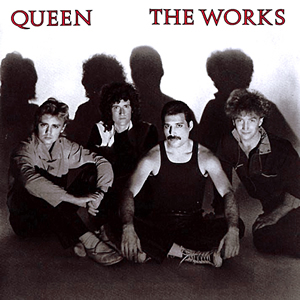
The decade began strong for the group, with the 1980 release of The Game , which topped the charts on both sides of the Atlantic and would become their best selling album. Later that same year, the group released the soundtrack to the movie Flash Gordon , which further expanded their audience and reach. A worldwide tour followed, which included several concerts with audiences topping 100,000 in Latin American in 1981. That same year, Queen worked with David Bowie on the single “Under Pressure”, a spontaneous occurrence, as Bowie happened to drop by the studio while Queen were recording, and another huge success, reaching number one in the UK. Late in 1981, Queen released their Greatest Hits compilation, which sold over 25 million copies worldwide and is still the best selling album in UK Chart history. However, 1982 turned out to be a disaster, not just with the flop of Hot Space , but with the inner turmoil which began to brew in the band, as guitarist Brian May and drummer Roger Taylor were both very critical of the new sound and its apparent abandonment of Queen’s core rock audience. For the first time in a decade, the group took a break from touring and recording, with some band members working on outside projects and solo albums.
After about a year apart, Queen reunited in August 1983 to begin work on this eleventh studio album. They convened in Los Angeles, making this the first time Queen recorded in America, and spent several months working on the album with co-producer and engineer Reinhold Mack . Here the group fused May and Taylor’s rock sound with some of the German-influenced electro pop advocated by vocalist and arranger Freddie Mercury , to fulfill the original mission laid out by Taylor, who stated at the beginning of recording, “Let’s give them the works!”
In what was probably an attempt to show the world that “Queen is back”, most of the songs on the albums first side, seem to harken back to previous famous songs by the band. May’s straight-forward anthem rocker “Tear It Up” contains a consistent beat that seems to slightly rip off the group’s own “We Will Rock You” from the 1977 album News of the World . Mercury’s piano ballad, “It’s a Hard Life” is pleasant and with good sound production, reminiscent of classic Queen of the 1970s, especially during the uplifting guitar lead by May. “Man On the Prowl” is a Jerry Lee Lewis inspired rockabilly track, complete with those famous Queen backing vocals, very similar to those used on the group’s 1979 hit “Crazy Little Thing Called Love”.
“Radio Ga Ga” was the lead single from The Works , as well as its opening track, and immediately feels like a breath of fresh musical air. This brilliant composition which combines a synthesized rhythm with pristine melody, was written by Taylor wholly on a synthesizer, but brilliantly arranged by Mercury, who really shines during the escalating pre-chorus, as the singer transforms the rather silly and trite lyrics into an uplifting and majestic piece. There is very little presence by May on this track, but when he does appear at the very end, he performs a simple slide lead which enhances the track further.
The album’s second side begins “Machines (Or ‘Back to Humans’)”, a really convoluted and disorganized song, which has no real direction and it appears to just throw in the “kitchen sink” of styles and techniques as a kind of extended filler. Deacon’s “I Want to Break Free” is far better than previous track, as it contains good pop craftsmanship, a cool rhythmic riff and a catchy vocal melody, resulting in a pure pop song that is impossible not to enjoy at some level. When Deacon insisted he didn’t want a guitar solo on the track, session man Fred Mandel was commissioned to perform a synth solo. Mercury’s “Keep Passing the Open Windows” starts as a dramatic piano track but, quickly morphs to a bass-driven rock track led by bassist John Deacon , which is fairly entertaining at first, But the trite lyrics grow old as the repetition increases through this five and a half minute track.
“Hammer to Fall” contains a catchy rock riff, catchy melody, and catchy harmonies, adding up to a latter-era Queen classic. Lyrically the song deals with the threat of imminent doom, but musically it feeds into the good-time, call-and-response of eighties pop/rock. This track should have concluded the album on a high note, but instead the group opted for the short acoustic folk ballad “Is This the World We Created?”, a very simple and somber piece by Mercury, which leaves the listener in a low mood as the album concludes. Not a bad piece, but should have been placed before “Hammer to Fall” for maximum effect.
Commercially, The Works did fine as an album, charting in the Top 20 in over a dozen nations worldwide. More importantly, Queen was restored as a top-level, headline act. By 1985, they were again once again playing in front of hundreds of thousands and they performed in front of millions at Live Aid in July of that year. During that festival, the visual of the entire audience at Wembley Stadium clapping in unison to “Radio Ga Ga”, has been cited as one of the greatest live performances of all time.

Part of Classic Rock Review’s celebration of 1984 albums.
Related Posts
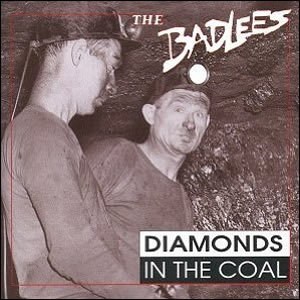
Album Reviews
Diamonds In the Coal by The Badlees
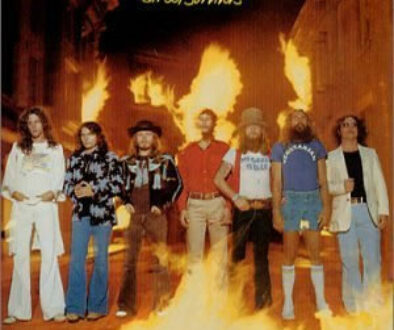
Street Survivors by Lynyrd Skynyrd
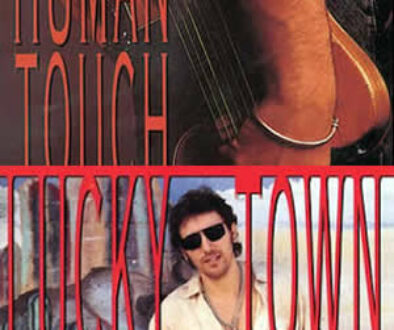
Human Touch & Lucky Town by Bruce Springsteen
John Deacon didn’t write Radio Gaga, Roger Taylor did.
Thanks for the head’s up, Richard. We’ve corrected the mistake.
Leave a Reply Cancel reply
Your email address will not be published. Required fields are marked *
By Parke Puterbaugh
Parke Puterbaugh
“Radio Gaga,” the single that opens up the new Queen album, is another instant jewel in Queen’s Top Forty crown. It’s one more anthemic lament to that overfamiliar icon, sung and played with Queenly overkill in “Deutschland Uber Alles” style by a group that did its share to corrupt the airwaves in the Seventies. This slab of false pomp aside, the rest of The Works — surprise, surprise — ain’t half bad.
Disregarding a best-of, a soundtrack, one single made with David Bowie and the obligatory solo projects, this is the glitter-rock band’s first real album in some time. And rather than move in ever-widening spirals of bombast, they’ve trimmed a lot of the excess — mainly, the fat vibrato of Brian May’s multitracked guitars and Freddie Mercury’s overdubbed tabernacle choir of vocal effects. What’s left is a lean hard-rock sound, making The Works perhaps the first record to refute the maxim that the words Queen and listenable are, of necessity, mutually exclusive.
Billie Eilish Would Like to Reintroduce Herself
Team trump is ready to lose the supreme court immunity case. they’re celebrating, taylor swift and jack antonoff have reached their limit, kanye west announces 'yeezy porn' amid reports of adult film company.
Granted, the messages have all been heard before and practically cancel each other out: love is all you need; let’s get physical; machines have feelings, too; be an individual, stand your ground. Instead, the revelations are in the music. For the carnivorous, rewards are to be found in the thundering Led Zeppelinisms of “Tear It Up” and “Hammer to Fall”; for the doubters, the surprises are in the comely melody and (relative) restraint of “Keep Passing the Open Windows” and the straight-up Fifties rocking of “Man on the Prowl.” And try this one our on the atheists: “Is This the World We Created…?” is an acoustic meditation on hunger and hate and generational responsibility, sung with conviction by Mercury.
This unanticipated humanitarianism is the perfect grace note to the preceding thrash-fest. The Works is a royal feast of hard rock without that awful metallic aftertaste; as such, it might turn out to be the Led Zeppelin II of the Eighties. Not so depressing a prospect at that.
Belinda Continues Her Bélica Rebrand With Natanael Cano Collab
- Corrido Coqueto
- By Tomás Mier
Santa Fe Klan Introduces Rich the Kid to His 'Música de Barrio' on New Collab 'Plomo'
After more than two decades in reggaeton, wisin is feeling more adventurous than ever.
- LLEGÓ EL FRONTÚ
- By Juan J. Arroyo
Babehoven’s ‘Water’s Here in You’ is a Contemplative Gem
- ALBUM REVIEW
Carin León Announces International Tour: 'From Hermosillo to Paris'
- De 🇲🇽 Pa'l 🌎
Most Popular
Anne hathaway says 'gross' chemistry test in the 2000s required her to make out with 10 guys: that's the 'worst way to do it' and 'now we know better', 'the lord of the rings' trilogy returning to theaters, remastered and extended, sources claim hugh jackman’s worrying behavior may have something to do with his breakup, first queen elizabeth ii memorial statue unveiled, with a smile and three corgis, in england, you might also like, meta and deloitte execs on the of genai in marketing and how it will disrupt the future of digital media, how grace kelly’s look-alike granddaughter camille gottlieb takes after her in philanthropy, style and jewelry, the best yoga mats for any practice, according to instructors, ‘diarra from detroit’ ends season 1 in a satisfying, deeply cinematic fashion, ncaa names nil registry partner after five-year process.
Rolling Stone is a part of Penske Media Corporation. © 2024 Rolling Stone, LLC. All rights reserved.
Verify it's you
Please log in.
- Main Discography
- Singles List
- Queen Books
- Freddie Mercury Biographies
- Brian May Biographies
- Queen Comic Books
- Song Books / Sheet Music
- Tour Programs
- Awards and Recognitions
- Chart Positions
- Queen Interview List
- Queen Songs in Commercials
- Queen Songs in Movies
- Queen Songs in Video Games
Following the disappointing reception to Hot Space and the lengthy and often grueling world tour, the band decided to take a break from each other and either work on their own or take some time to relax with their families. For three-quarters of the band, 1983 started off peacefully enough, until their own creative juices started to flow again, and solo work became the priority for the year: in April, Brian worked with a group of four friends on what would become Star Fleet Project , while Freddie and Roger worked on their first ( Mr. Bad Guy ) and second solo albums ( Strange Frontier ), respectively. John, meanwhile, did some light session work, but spent his time mostly not playing any music whatsoever.
In the summer of 1983, the band's manager, Jim Beach , was in discussions with director Tony Richardson, who was working on a film adaptation of John Irving's 1981 novel, The Hotel New Hampshire . The band were approached to provide a soundtrack to the film, and, despite (or perhaps in spite) of the experiences endured while working on Flash Gordon in 1980, the band agreed. However, at the same time, they had also agreed to work on their next studio album, meaning that they would be recording two projects simultaneously. The band reconvened in August at The Record Plant in Los Angeles, becoming the first (and only) time that the band would record in the United States; sessions commenced with stunning productivity, though it became apparent that working on two major projects at the same time was exhausting and time-consuming. Richardson, using the excuse of an insufficient budget, let the band go of the project; one known song, Freddie's Keep Passing The Open Windows , had been written and recorded for the film before Richardson's decision.
Hardly losing any sleep over the loss, the band continued working on their album, switching midway through the sessions from Los Angeles to Munich. Ten known songs - all that ended up on the album, as well as the non-album B-side I Go Crazy - were recorded, though additional outtakes include songs that ended up on Freddie's first solo album ( There Must Be More To Life Than This and Man Made Paradise ) as well as his first single ( Love Kills ), while Freddie explained that Roger had written about four or five songs for the album before coming up with Radio Ga Ga (it's likely these songs were ultimately released on Roger's second solo album). Brian, too, was writing more, and reportedly submitted Let Me In (Your Heart Again) for the sessions, which was recorded but remained unreleased; the song would later be given to his girlfriend Anita Dobson , who recorded it in 1987 on her debut album, Talking Of Love . More mundanely, the foundation of Let Me Live was recorded in Los Angeles as Another Piece Of My Heart , a brief jam with Rod Stewart on additional vocals and Jeff Beck on guitar.
If the sour taste of Hot Space had affected the band's productivity, they didn't show it. Instead of advancing on the sounds of their previous album, they instead fell back into a system of using whatever works best; as a result, most of the songs hark back to other eras of the band's illustrious history. Tear It Up recalls the crunching beat of We Will Rock You , while Man On The Prowl was written as a latter-day Crazy Little Thing Called Love . Unfortunately, rock songs (the aforementioned Tear It Up , and Hammer To Fall , both tracks, incidentally, written by Brian) took a back seat to more pop-oriented material like Roger's Radio Ga Ga and John's I Want To Break Free , both of which featured extensive arrangement involvement from Freddie. On a lighter note, synthesizers and drum machines were finally integrated successfully into Queen's music; for the purist fans, this was hardly resounding news, but it should be remembered that this was 1984, and that synthesizers and drum machines were the latest trend.
The album was released in February 1984, a mere fortnight after Radio Ga Ga (which reached #2 in the UK and a respectable #16 in the US), going on to peak at #2 in the UK and a disappointing #23 in the US. Subsequent singles all reached the Top Twenty in the band's home country ( I Want To Break Free , #3; It's A Hard Life , #6; and Hammer To Fall , #13; a fourth single, Man On The Prowl , was slated for release in November 1984, but was withdrawn and instead replaced with the seasonal Thank God It's Christmas ), though these same singles performed poorly in the US, reaching #45, #72, and not charting at all, respectively. There are many factors to this: the band had just switched record companies, from Elektra to Capitol , and while initial sales of Radio Ga Ga were promising, a scandal erupted, which Brian explained: "Capitol got themselves into trouble with a dispute that raged in the early 1980s over the alleged corruption of independent record promoters in the US. It was basically the ring of bribery that went on to get records played on US radio. There was a government enquiry into it, and everybody shut down very, very fast. Without going into it too deeply, Capitol got rid of all their 'independent' guys - and the reprisals from the whole network were aimed directly at all the artists who had records out at that time. We had Radio Ga Ga which I think was Top Twenty and rising, but the week after that it disappeared from the charts." This soured relations between band and record company, and the band's Stateside popularity would never recover. At the same time, Freddie's personal manager, Paul Prenter , was doing his part in damaging the band's reputation by being nasty and dismissive toward media outlets who were generally interested in talking to the band, Freddie in particular. (Contrary to popular belief, the video of I Want To Break Free did not damage Queen's reputation in the United States; though there were areas - particularly the deep south - who didn't find the video amusing, the video was well-received in the more populous areas of the coasts.) Consequently, the band refused to tour the United States again, instead focusing their energies on other countries.
The album was remastered and reissued in 1991 on Hollywood Records , with three bonus tracks: the non-album B-side I Go Crazy , and extended remixes of Radio Ga Ga and I Want To Break Free . Further extended remixes of It's A Hard Life , Man On The Prowl , Keep Passing The Open Windows , and Hammer To Fall (dubbed the 'Headbangers mix') were also created, while an instrumental remix of Machines (Or 'Back To Humans') was also created for the US market, specially by Brian. These tracks appeared on the The 12" Collection , in 1991.
- Produced by:
- People Weekly
LP Releases
Cd releases, cassette releases, promotional material.
- This page has been accessed 88,589 times.
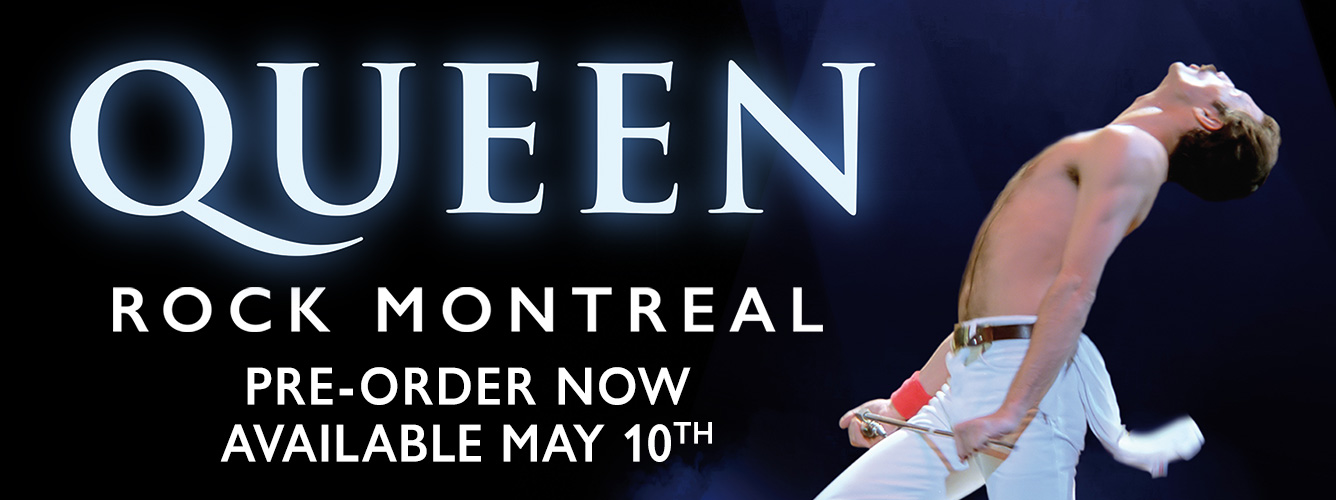
“This is Queen! This is our music and this is how we present ourselves."
Register here
“This is us, and it is up to you to interpret it."
“we are four equal, interwoven parts.".

Japan: Queen Day In Spring 2024
.jpg)
Today: “Cool Cat" Released As 7” Single for Record Store Day
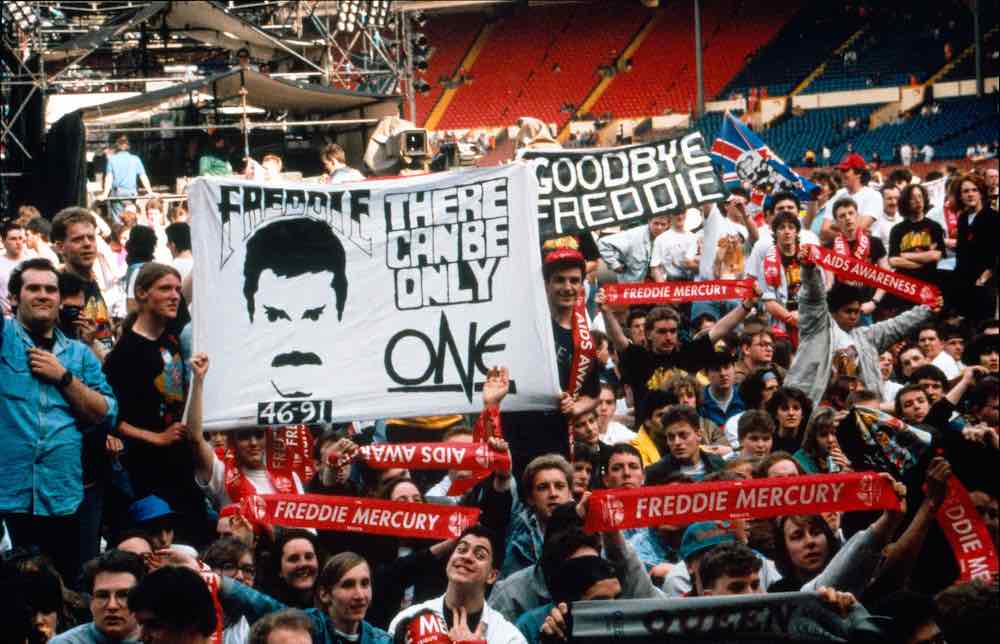
The Freddie Mercury Tribute Concert - 32 Years On...
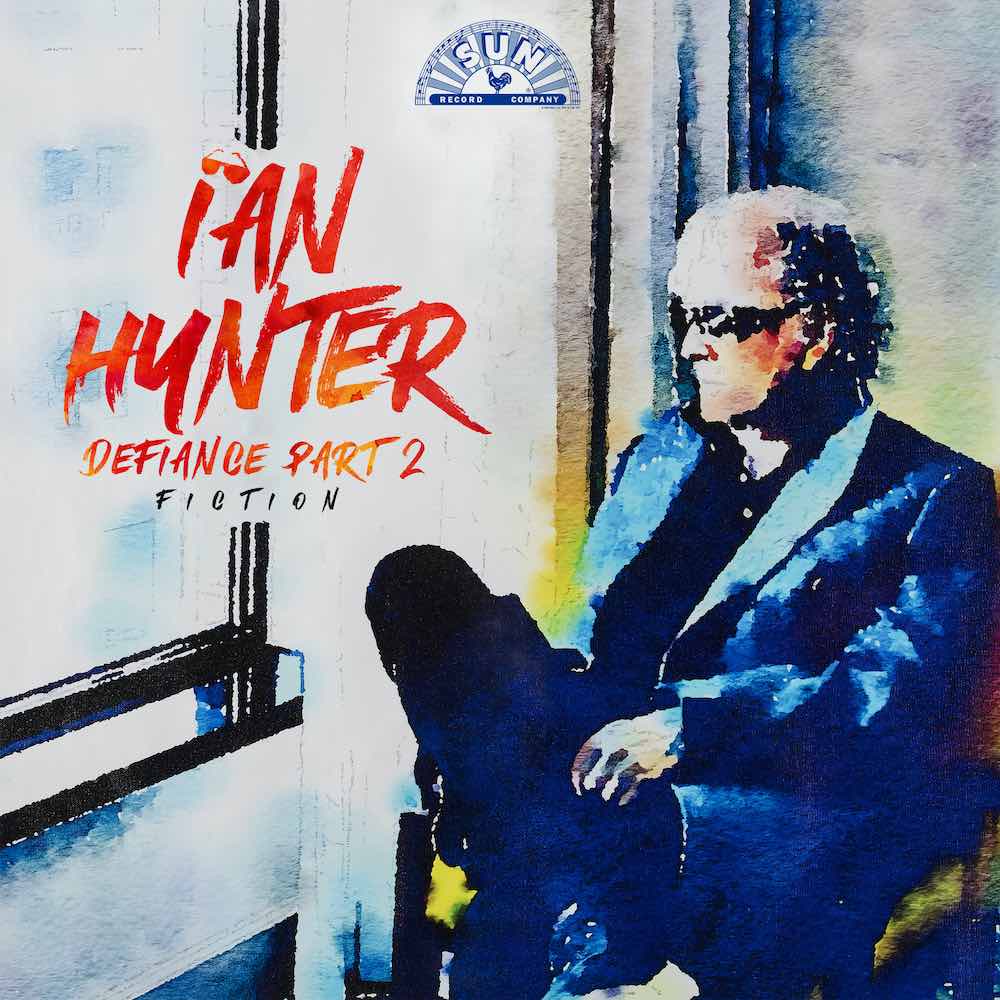
Out Today: New Ian Hunter Album Featuring Brian
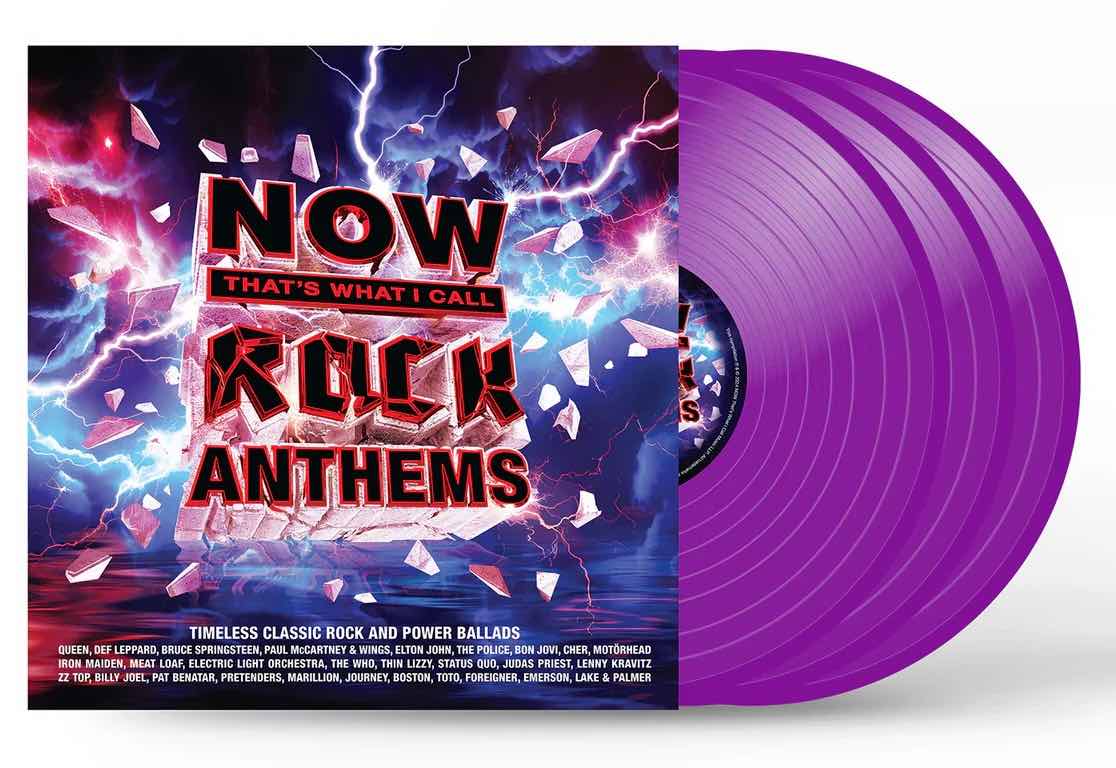
'Don't Stop Me Now' on NOW That’s What I Call Rock Anthems
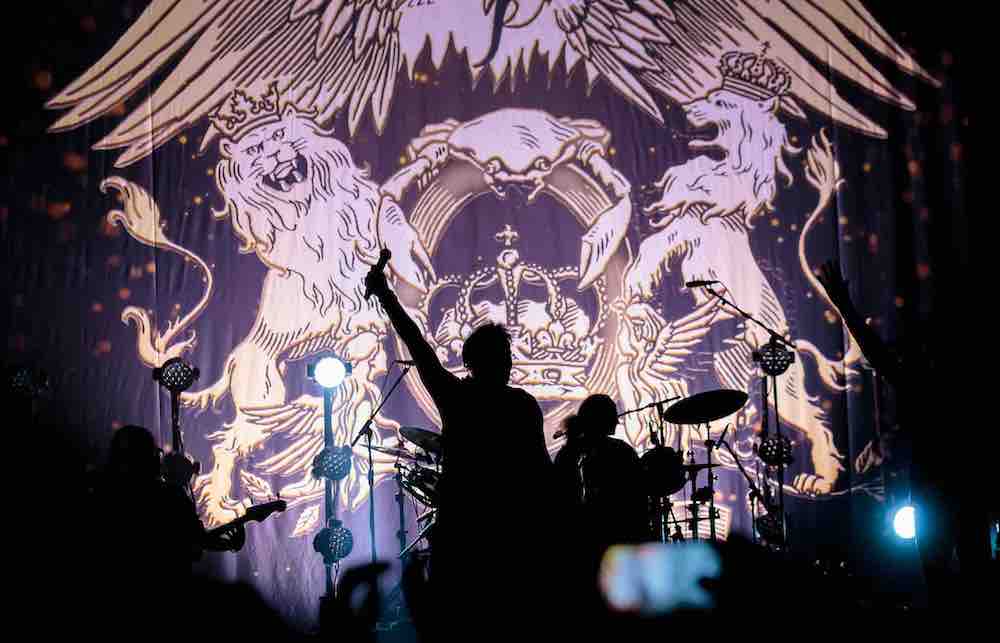
QuEx: Final Show Photo Gallery
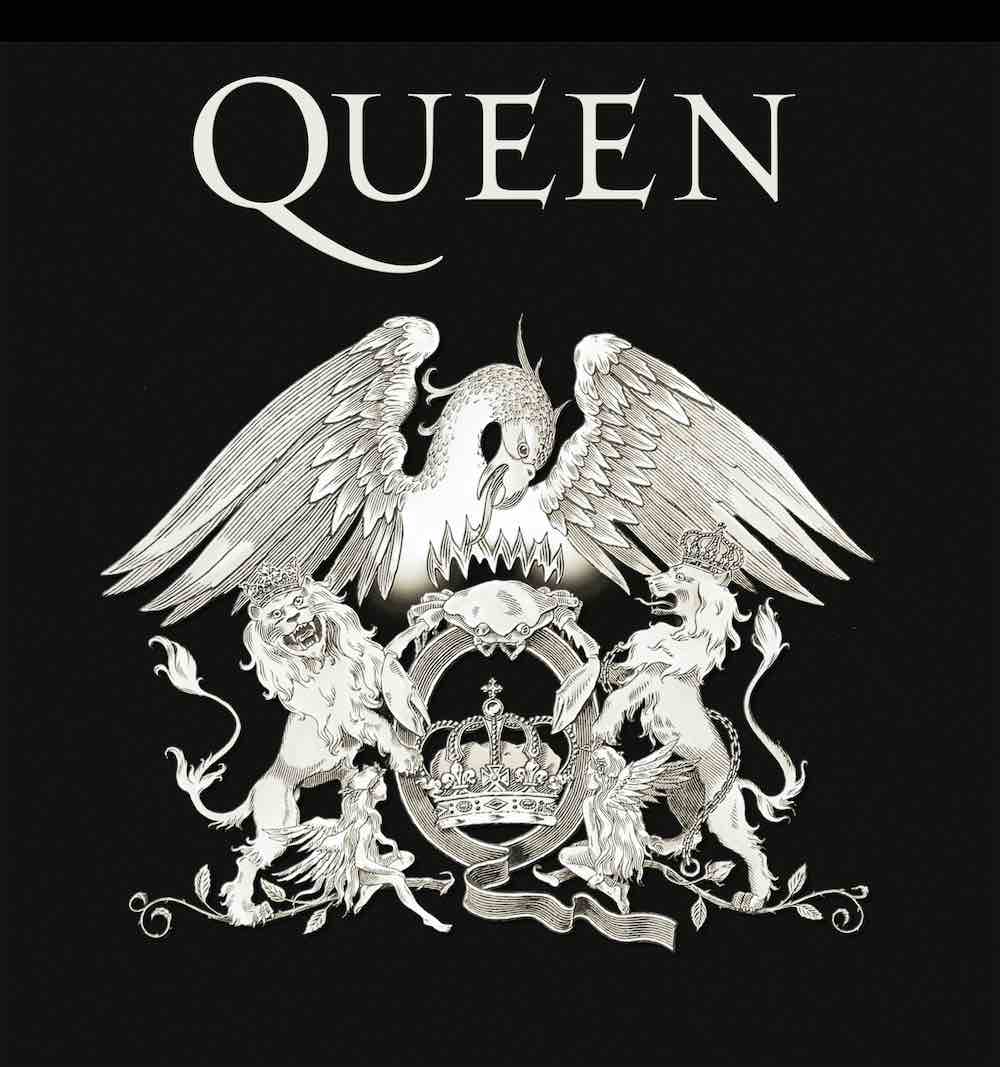
Important Notice: Fake Accounts
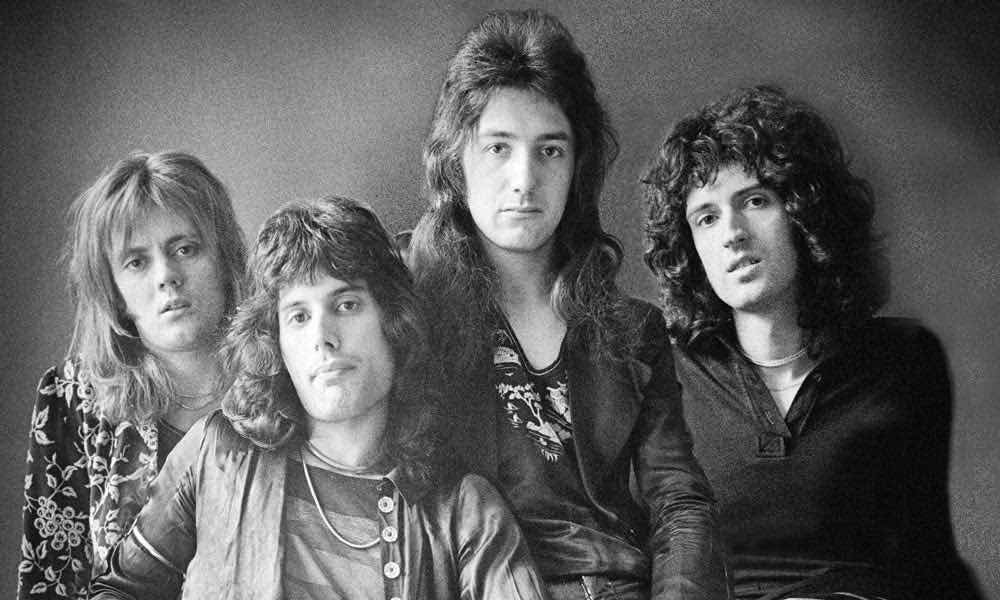
uDiscover: Big Spenders On Campus, Queen Make Their US Live Debut
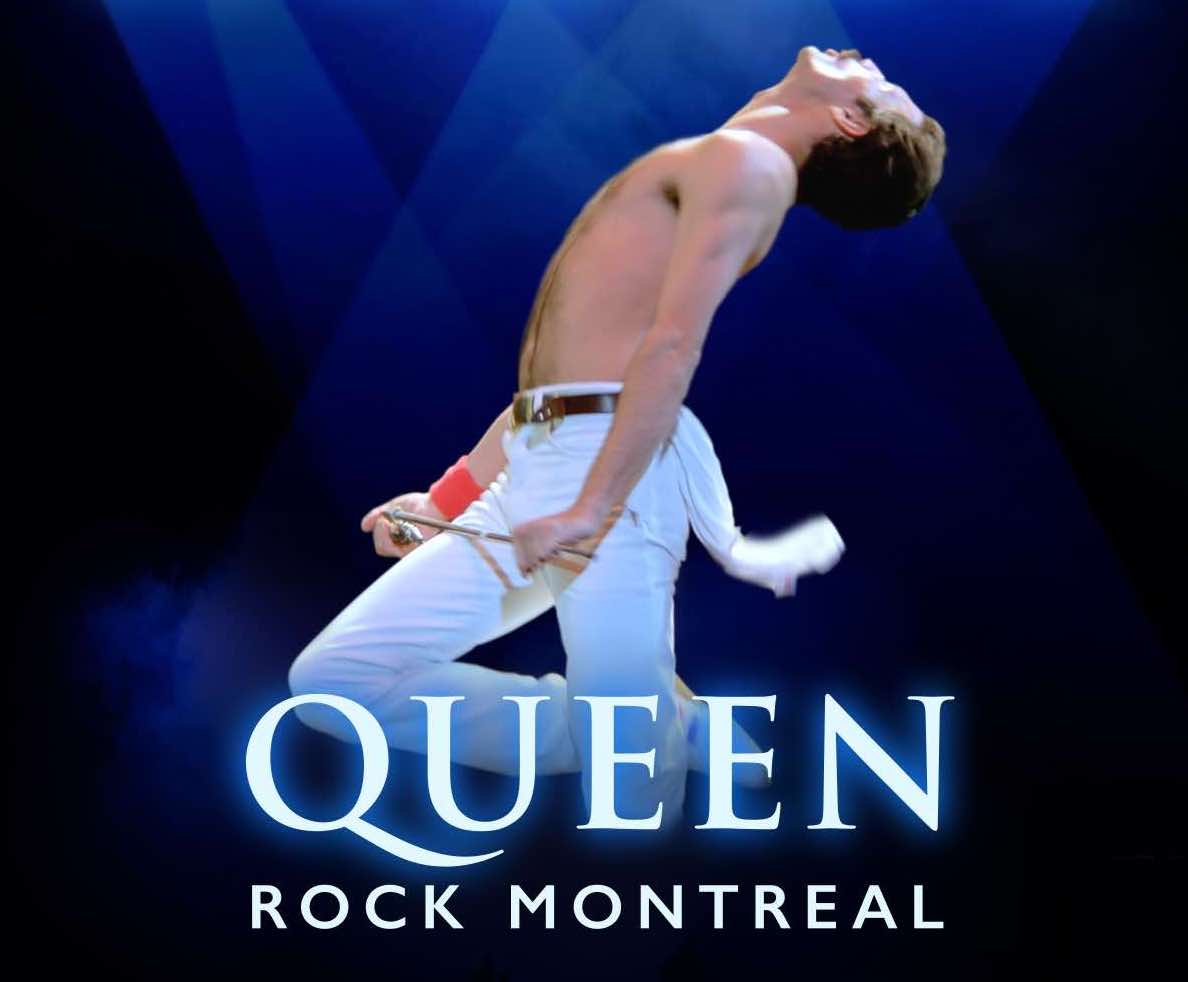
'Queen Rock Montreal' Coming to Disney+
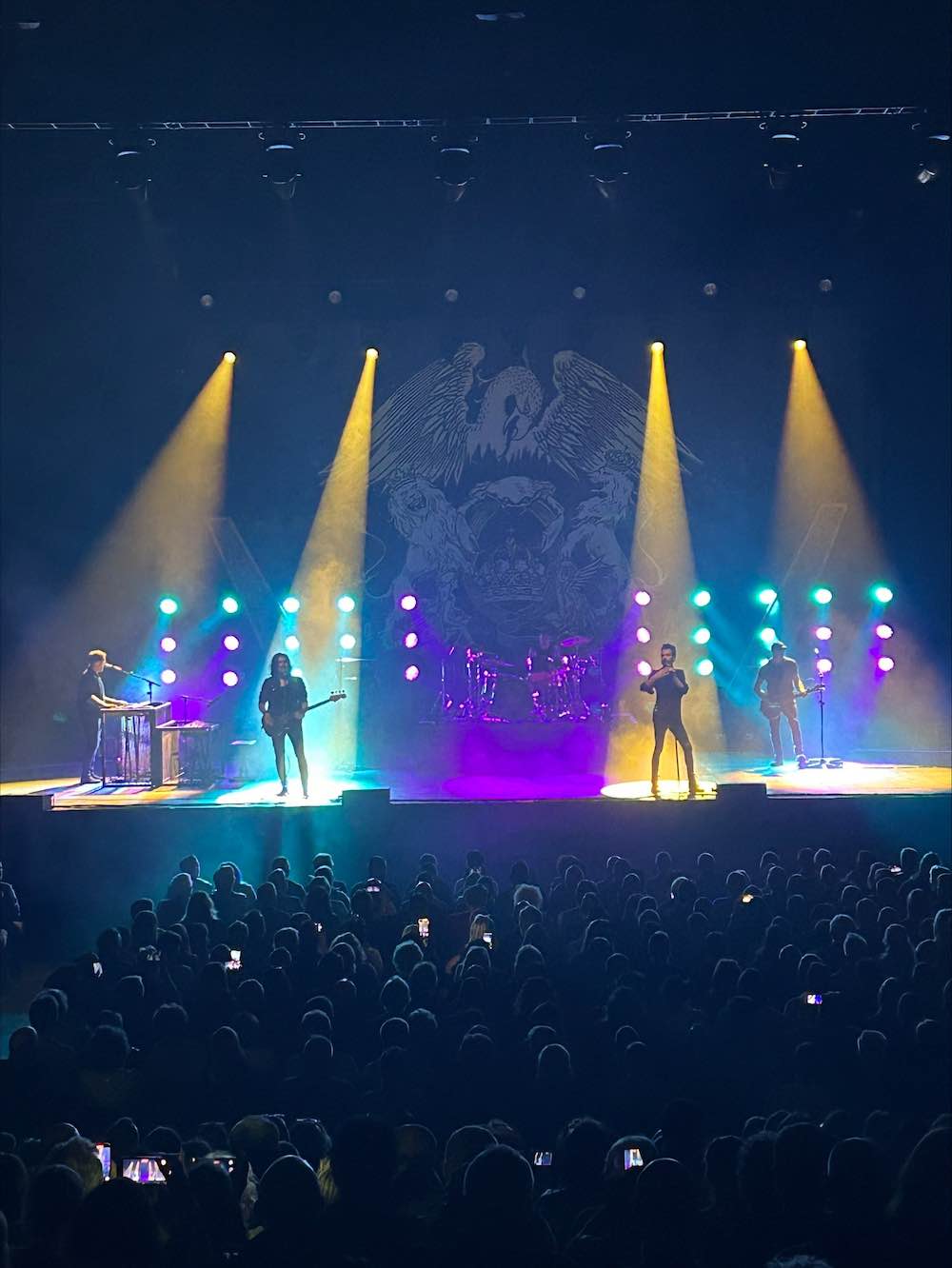
The QuEx Tour: Thank You & Set List
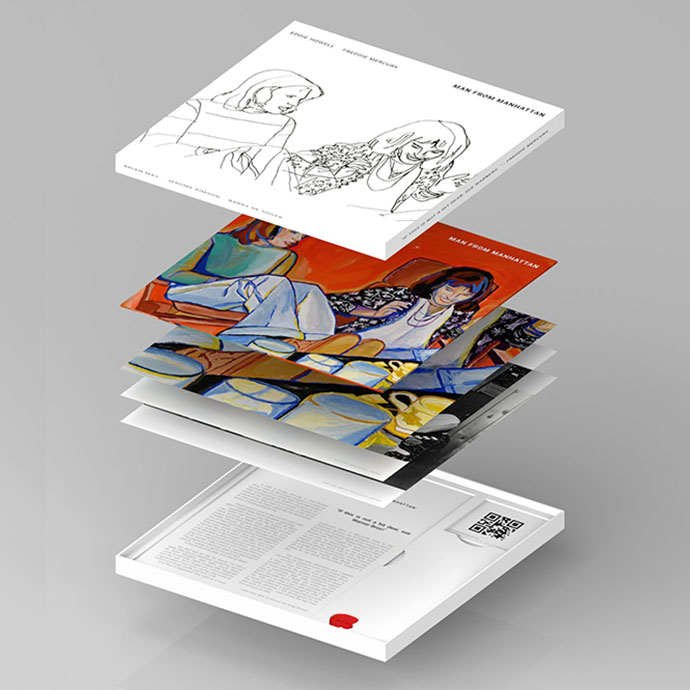
'Man From Manhattan' LP Box Set Released Today

Watch Now: "Another One Bites The Dust" on YouTube

RBC Heritage: How to watch Monday finish, live scores, tee times, TV times
Change Text Size
A Monday finish will take place at the RBC Heritage after the final round was suspended due to darkness Sunday evening at 7:45 p.m. ET. Play resumes at 8 a.m. on Monday morning as Scottie Scheffler looks for back-to-back wins for a second time this season and his fourth win in five starts. The world No. 1 holds a five-shot lead with three holes remaining. This will be the second unscheduled Monday finish on the PGA TOUR this season and first since the Cognizant Classic in The Palm Beaches.
Here's everything you need to know to follow the action.
HOW TO FOLLOW (all times ET)
Television:
- Monday: 8 a.m. (Golf Channel, Peacock)
PGA TOUR Radio on SiriusXM and free on PGATOUR.COM/liveaudio :
- Monday: 8-9 a.m.


Lisburn woman diagnosed with ADHD aged 46 starts support group
"It was all just getting on top of me, I just wanted to scream and run away."
Transformation work begins on 'well-loved' Lincoln building with new images released
The former Barbican Hotel, opposite Lincoln railway station, will re-open in January 2025
How your MP in Berkshire voted on deporting illegal immigrants to Rwanda
The project to deport illegal immigrants to Rwanda has become law after clashes in both houses of Parliament – find out how your MP voted.
Ever Seen A Demon In The Middle Of The Night? You Weren't Imagining It
It almost definitely wasn't a real demon, but you probably did see something.
Two people hit with hammer and pet threatened with knife during terrifying late-night burglary
The terrifying incident took place in a flat on Pinero Grove in Hartlepool
Labour unveil plans to nationalise trains with 'Great British Railways'
LABOUR has unveiled plans to create a new publicly-owned company called Great British Railways to nationalise much of the sector ...
Oman, UAE deluge 'most likely' linked to climate change: scientists
Global warming caused by fossil fuel emissions "most likely" exacerbated the intense rains that lashed the UAE and Oman last week, causing deaths and widespread flooding, an expert group of scientists said Thursday."The UAE and Oman floods have shown that even dry regions can be strongly affected by precipitation events, a threat that is increasing with increasing global warming due to fossil fuel burning," said Sonia Seneviratne, a WWA member and professor at Zurich's ETH university.
Martin Lewis says take 30 seconds to act after 20,000 people receive message
The host for This Morning, Good Morning Britain and The Martin Lewis Money Show aired his concerns on Twitter
Meghan Markle's 'three-word reply' to Prince Harry's 'unexpected interruption' at event
Meghan Markle and Prince Harry made their first public appearance alongside Prince William and Kate Middleton in 2018, but a Royal author has claimed it was marred by an awkward moment
Down-on-his-luck dad collared on M6 in BMW packed with shopping bags
Officers said it was 'possibly the biggest seizure in recent years' - and Leonard Simpson was offered £2,000 to get it to Scotland
Glasgow Uber passenger's one mile trip costs more than flight to Spain
A Glasgow Uber passenger - who has severe arthritis - was left raging after a one mile trip from home to a dentist appointment cost him more than a flight to Spain.
Paula Vennells ‘interjected’ in talks to stop subpostmaster prosecutions
The Post Office executive committee was in favour of ceasing prosecutions entirely, a former top lawyer told an inquiry.
Married couple charged over ‘dine and dash’ spree
A married couple have been charged over an alleged string of “dine and dash” incidents where restaurants were left hundreds of pounds out of pocket.
Teen brother of girl arrested for Wales school stabbing taken into custody
Police have arrested the brother of a girl who allegedly stabbed two teachers and a pupil at a high school in Wales, The Telegraph understands.
Man had already attacked three former partners when he told new girlfriend 'be quiet or I'll kill you' then strangled her
Tremaine Actie, 31, begged his victim to not tell the police what he had done and threatened to kill himself if she did
Seventy Israeli hostages have been killed, says captive
Around half of the remaining Israeli hostages abducted by Hamas have been killed in Gaza, an Israeli-American captive said in a rare proof-of-life video.
‘Game of Thrones’ Spinoff ‘10,000 Ships’ Revealed as Moses-Inspired Epic About Queen Nymeria’s Exodus: ‘My Work Is Still There if HBO Wants to Pick It Up’
By Zack Sharf
Digital News Director
- Jessica Lange Says ‘Corporate Profit’ Is Overwhelming Hollywood and ‘So Much of the Industry Now Is Not About the Creative Process’ 2 hours ago
- Emily Blunt Says Algorithms ‘Frustrate Me’ and ‘I Hate That F—ing Word’: ‘How Can We Let It Determine What Will Be Successful?’ 2 hours ago
- Anne Hathaway Says ‘The Princess Diaries 3’ Development ‘Is in a Good Place,’ but ‘There’s Nothing to Announce Yet’ 3 hours ago

Brian Helgeland’s illustrious Hollywood career includes winning an Oscar for writing “L.A Confidential,” directing Heath Ledger’s beloved 2001 comedy “A Knight’s Tale” and scripting films such as “Man on Fire” and “Mystic River.” It also could’ve included a “ Game of Thrones ” spinoff series had HBO moved forward on his pitch, which was titled “Ten Thousand Ships” and centered on Queen Nymeria.
“Essentially, it was the story of Moses but swapping him out for Nymeria,” he continued. “Her country gets ruined and her people are forced to live on the water, which is why the show was called ‘Ten Thousand Ships.’ They end up having to leave and find a new home like the Israelites leaving Egypt. She’s leading all these people, trying to hold everyone together but things are always in danger of falling apart as they travel around a fictionalized version of the Mediterranean, looking for a new home to settle in.”
Helgeland’s involvement in a “Game of Thrones” spinoff was revealed as early as 2017, a few years before the flagship HBO series came to an end. In May 2021, screenwriter Amanda Segel was hired as a writer on the series. But the show never got an official greenlight from HBO, although Helgeland maintains “nothing is ever dead.”
“Their life was nomadic. Living in a raft city that was bound together, this big floating city,” Helgeland said about his plans for Nymeria and her people in the spinoff. “Sometimes, the characters would come ashore, but they ultimately get driven off the land as they search for a home, their version of the promised land.”
“Thrones” already has one spinoff series that made it air thanks to “House of the Dragon,” which returns for a second season this summer. A second spinoff series, “A Knight of the Seven Kingdoms: The Hedge Knight,” recently announced its main cast members (Peter Claffey has been cast as Dunk, while Dexter Sol Ansell has been cast as Egg) and is set to go into production later this year. One planned spinoff that is not moving forward is a “Thrones” sequel series centered on Kit Harington’s Jon Snow .
“I hadn’t really ever spoken about it, because it was in development,” Harington told ScreenRant about the spinoff earlier this month. “I didn’t want it leaked out that it was being developed. I didn’t want the thing to happen where people kind of start theorizing, getting either excited about it or hating the idea of it, when it may never happen. Because in development, you look at every angle, and you see whether it’s worth it.”
He continued, “And currently, it’s not. Currently, it’s off the table, because we all couldn’t find the right story to tell that we were all excited about enough. So, we decided to lay down tools with it for the time being. There may be a time in the future where we return to it, but at the moment, no. It’s firmly on the shelf.”
Head over to Inverse’s website to read Helgeland’s full interview.
More From Our Brands
How to watch the knicks vs. 76ers nba playoff series without cable, dubai just got 3 new luxe hotels. here’s a look inside., ncaa names nil registry partner after five-year process, be tough on dirt but gentle on your body with the best soaps for sensitive skin, nicholas alexander chavez not returning to general hospital as spencer (exclusive), verify it's you, please log in.
Priscilla, Queen of the Desert sequel announced 30 years after beloved film's original release
A sequel to the Australian cult classic movie The Adventures of Priscilla, Queen of the Desert, is in the works with the original main cast all set to return on screen.
"I'm not repeating myself, we'll start the new film in Australia, but by God, we're going on one helluva journey," the director of the celebrated 90s movie Stephan Elliott told Deadline .
"The original cast is on board, I've got a script that everybody likes, we're still working out deals. … It's happening," Mr Elliott said.
The news comes 30 years after the movie, starring Hugo Weaving, Terence Stamp and Guy Pearce, was released at the 1994 Cannes Film Festival.
Priscilla became a surprise hit, with its positive portrayal of LGBT characters winning audiences over worldwide and lifting it to the status of a beloved classic, at a time where drag artistry remained largely invisible to mainstream audiences.
It tells the story of three drag performers, played by Weaving, Stamp and Pearce, travelling through the Australian outback on a bus called Priscilla.
Weaving plays Anthony "Tick" Belrose, a Sydney drag queen going by the drag name Mitzi Del Bra, who accepts an offer to perform a four-week run at an Alice Springs casino managed by his estranged wife Marion.
Tick is joined by his friends and fellow performers, bereaved trans woman Bernadette Bassenger (played by Stamp) and younger queen Adam Whitely (Pearce), who's drag name is Felicia Jollygoodfellow, and the three get on the road in a large tour bus — Priscilla, Queen of the Desert.
The cast's glittery dresses and extravagant headpieces won the Oscar for best costume design for the work of Australian costume designer Tim Chappel at the 67th Academy Awards, and the movie also received a BAFTA for best makeup and hair.
Mr Chappel spoke to the ABC of the film's lasting impact in 2014, saying he is regularly contacted by people from around the world who have only just seen it for the first time.
"I get emails from young people and young gay people in other countries who say the film has opened their world and made them feel free," he said.
The story has since been turned into an award-winning stage musical, called Priscilla The Party.
Mr Elliott said he was hesitant to make a sequel until now out of fear of repeating himself.
"I thought, what am I going to do? Stick them on a cruise ship, stick them on a train? You name it, over the years I've been pitched Priscilla 2 in spades."
It was the death of his parents within two years of each other that changed his mind.
"I was writing and configuring after dad died in early 2020," Mr Elliott told Deadline.
"Then mum died in early 2023. It was a tough one, and so I finally realised that I do have something to write about."
The soundtrack to the follow-up will feature "old disco classics", but also more modern pop music, Mr Elliott said, flagging the possibility of a Lady Gaga number.
"We've got to move with the times," he adds.
Priscilla the bus herself was thought to be lost for almost 25 years, until it resurfaced at a rural property in New South Wales in 2019, having survived bushfires and floods.
The bus, which is being restored with the help of a public fundraising campaign and will eventually be displayed at the National Motor Museum in South Australia, will feature in the movie, Mr Elliot said.
"I don't know how it survived but we have a plan," he said.
"It's the 30th anniversary, the bus has been found, Priscilla the Party! is about to roll out globally and it's time for Priscilla's final adventure to get made."
Mr Elliott will again serve as director and writer, as well as a co-producer.
An official announcement on the sequel will come soon after various negotiations are completed, he said, with original creatives welcomed back on board if they are available.
- X (formerly Twitter)
Related Stories
Long-lost priscilla, queen of the desert bus to be restored to her former glory.
Film history preserved in Priscilla costumes
Iconic Palace Hotel in Broken Hill, home of murals and drag festival, up for sale
- Arts, Culture and Entertainment
- Film (Arts and Entertainment)
- Film Industry
- Preplanned tours
- Daytrips out of Moscow
- Themed tours
- Customized tours
- St. Petersburg
Moscow Metro
The Moscow Metro Tour is included in most guided tours’ itineraries. Opened in 1935, under Stalin’s regime, the metro was not only meant to solve transport problems, but also was hailed as “a people’s palace”. Every station you will see during your Moscow metro tour looks like a palace room. There are bright paintings, mosaics, stained glass, bronze statues… Our Moscow metro tour includes the most impressive stations best architects and designers worked at - Ploshchad Revolutsii, Mayakovskaya, Komsomolskaya, Kievskaya, Novoslobodskaya and some others.
What is the kremlin in russia?
The guide will not only help you navigate the metro, but will also provide you with fascinating background tales for the images you see and a history of each station.
And there some stories to be told during the Moscow metro tour! The deepest station - Park Pobedy - is 84 metres under the ground with the world longest escalator of 140 meters. Parts of the so-called Metro-2, a secret strategic system of underground tunnels, was used for its construction.
During the Second World War the metro itself became a strategic asset: it was turned into the city's biggest bomb-shelter and one of the stations even became a library. 217 children were born here in 1941-1942! The metro is the most effective means of transport in the capital.
There are almost 200 stations 196 at the moment and trains run every 90 seconds! The guide of your Moscow metro tour can explain to you how to buy tickets and find your way if you plan to get around by yourself.
Madonna Talks Life on Tour With Her Kids: “Nothing Brings Me More Happiness”

Madonna has been clear from the beginning that The Celebration Tour is no mere “greatest hits” circuit. It’s more like an artist’s MoMA retrospective blown up into an arena tour showcasing her singular contributions to the culture. It’s also the Queen of Pop’s most deeply personal tour yet, paying tribute to her influences, mentors, parents, and the friends and collaborators she’s lost. Nowhere is that personal touch more apparent than the inclusion of four of her children in the show. Across 78 performances so far, Madonna has worked double-duty as mom with son David and daughters Mercy, Stella, and Estere along for the ride—each one getting their own moment on stage. Mercy accompanies her mother on piano during “Bad Girl,” while David duets with his mom on “Mother and Father” (which, apparently, required the young musician to work up a bit of confidence to do). Twins Stella and Estere meanwhile, show off their dance skills during “Don’t Tell Me” and a segment dedicated to ballroom.
Ahead of her final arena dates in Mexico and a historic (potentially record-breaking) free show in Rio de Janeiro, Madonna sat down to answer questions over e-mail about life on the road with her children.
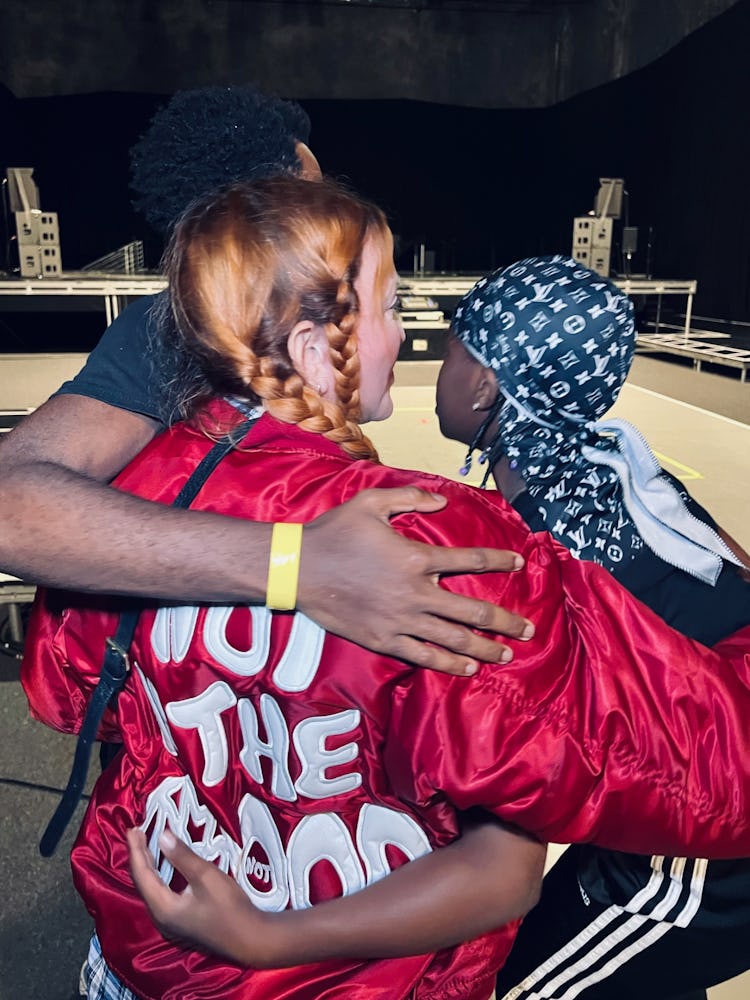
Madonna with Estere and David.

Madonna with David.
Rocco performed on stage during MDNA , and Lola worked in the wardrobe department on that same tour. Your children always seem to be involved in some capacity with your work. How does that feel as a mother?
I have always been blessed with children who are interested in music, dance, and art. Starting from the top with Lola , who was not only an incredible ballet dancer and and a rhythmic gymnast, switching to musical theater and contemporary dance. Now she is a unique singer and song writer in her own right. When I go on tour, nothing brings me more happiness to know, we are all working on the same show creating the magic together. It would be boring if they were just traveling from hotel to hotel, and occasionally coming to watch the show. Of course, I am also their mother so sometimes we get on each other’s nerves. We are a family of artists but are also a family and that’s what happens.

Estere during dance practice.

Madonna, Mercy, and her piano teacher Ric’Key Pageot.
It seems like your children have been honing their talents for years. How important is it for you as a mother to make sure they take their art seriously?
Because The Celebration Tour is a retrospective of my life, I thought it made perfect sense to include all of my children still living with me in the show. As they all dance, and play musical instruments, and have been doing so for years. David has played guitar since he was a child. Mercy has played piano since she was eight and has been classically trained most of her life. Eventually, when I adopted the twins, they started to play piano and dance as well. There is always an endless parade of music and dance teachers coming and going in our house. And then we add to that Djing as Estere showed a keen interest in learning. She started taking DJ lessons and took it very seriously.
Madonna and Mercy onstage performing “Bad Girl.”
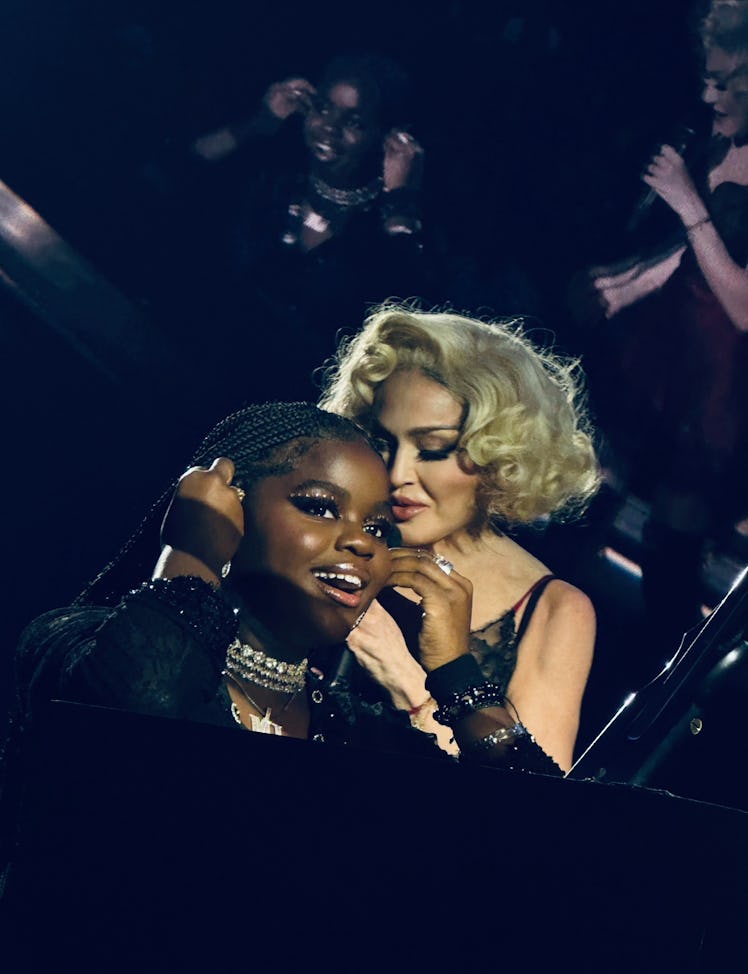
Each of the children has their own moment in the show. Mercy James playing piano during “Bad Girl” was a highlight. Any back story on how that all came together?
I saw a strange poetic juxtaposition of hedonism, erotic exploration emerging into the light of Mercy, sitting stoically at her grand piano playing Chopin as she beckoned me towards her, making me think about the choices I have made in my life. Singing “Bad Girl” was kind of a confession, not an apology, and I felt we had an unspoken understanding of what was happening.
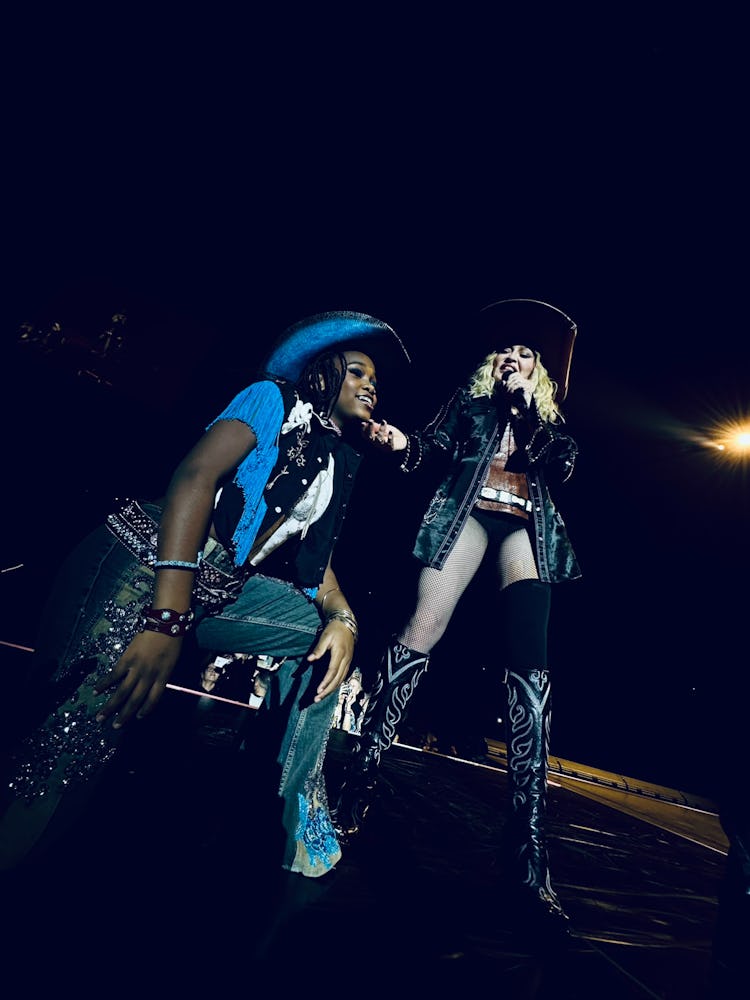
Stella dancing during “Don’t Tell Me.”

Stella and Mercy.
Stella performs in “Don’t Tell Me,” which is a big number during the show. How was she with learning the choreography?
Stella, who I would say is my shyest child, comes alive on stage, and I love having her as my little cowgirl. But she happens to be an incredible fine artist, and I’m hoping that she follows in the footsteps of Rocco who after being a B-boy, skater, and graffiti artist has really come into his own as an incredible painter.

David and Madonna performing onstage.
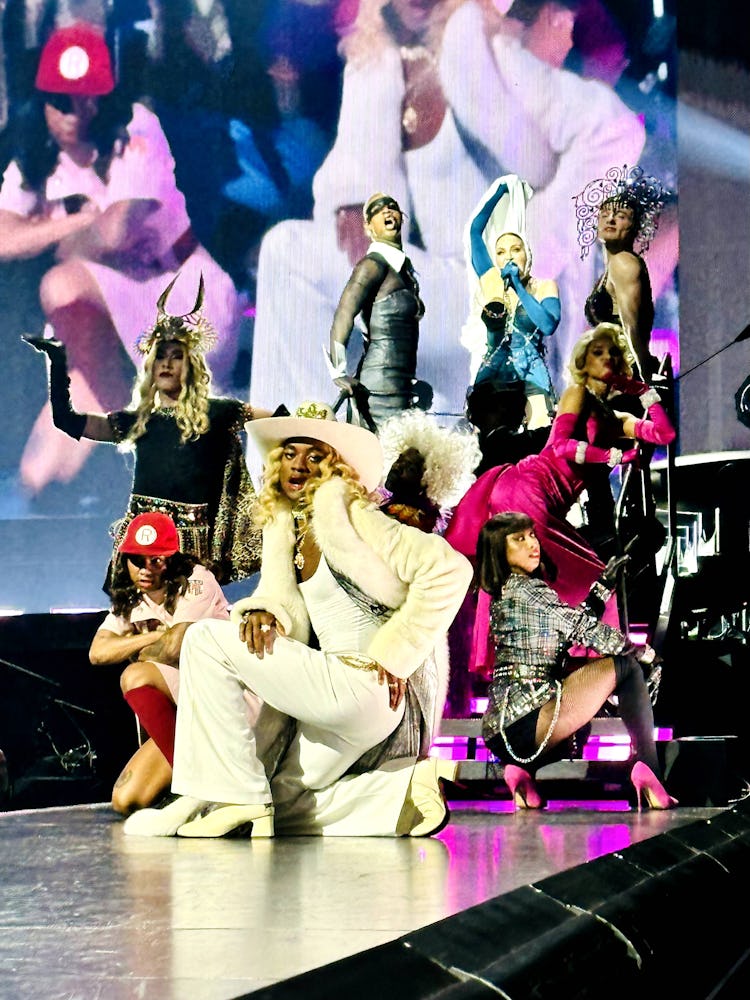
David during the show’s finale.
David singing a verse during “Mother and Father” was fantastic. Has he expressed any interest in following in your footsteps with a musical career? He had originally only played guitar at the beginning of the tour. Did it take some convincing to get him to sing?
“Mother and Father” is one of my favorite moments in the show because it gave me a chance to not only honor my mother and her memory but also to honor David’s mother and her memory. He has always wanted to sing and play guitar. He loves being on stage. This is nothing new. I love that we both get to sing to our mothers. Much of the show is about motherhood, family, and the importance of that in my artistic life.
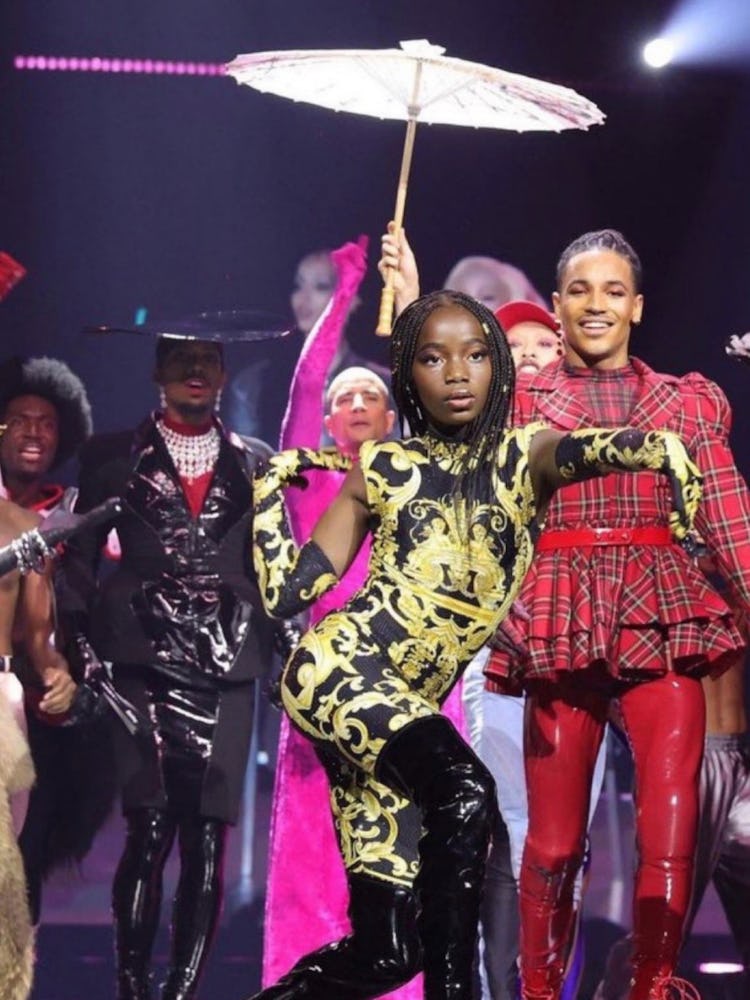
Estere showing off her moves.

Estere, backstage in a “Britney Spears” t-shirt.
How did Estere get so into ballroom? Does she have any vogue mentors (aside from you)?
While Estere was learning how to DJ she became interested in ballroom competitions and just by luck, one of my choreographer’s assistants, Ivy Mugler, has her own ballroom house called House of Mugler. She started taking Estere aside during rehearsals in another room, and within a couple of weeks she was doing death drops and spins and surprising us with her ability. So, of course we had to turn that section of the show into Estere’s Ball.
Because this tour is a celebration of your entire career, did you kids learn or realize anything new about you?
I think what my children learned the most in this year of rehearsing and performing is that if you want to follow your dreams, you have to work hard for them. And if all of them choose something different later in life, they will never forget this year of blood, sweat, and tears.

David, Stella, Mercy and Estere.

Estere studying.
The tour just wrapped up its U.S. dates. With five shows in Mexico City coming up and the huge free concert in Rio, what’s going through your mind right now?
This show was created for an indoor arena. Transforming and adapting it to perform outdoors on the beach, with no roof in Rio is going to be quite an undertaking and full of surprises. God willing, we will pull it off, and it will be an experience they will never forget.
Moscow Metro Tour
- Page active

Description
Moscow metro private tours.
- 2-hour tour $87: 10 Must-See Moscow Metro stations with hotel pick-up and drop-off
- 3-hour tour $137: 20 Must-See Moscow Metro stations with Russian lunch in beautifully-decorated Metro Diner + hotel pick-up and drop off.
- Metro pass is included in the price of both tours.
Highlight of Metro Tour
- Visit 10 must-see stations of Moscow metro on 2-hr tour and 20 Metro stations on 3-hr tour, including grand Komsomolskaya station with its distinctive Baroque décor, aristocratic Mayakovskaya station with Soviet mosaics, legendary Revolution Square station with 72 bronze sculptures and more!
- Explore Museum of Moscow Metro and learn a ton of technical and historical facts;
- Listen to the secrets about the Metro-2, a secret line supposedly used by the government and KGB;
- Experience a selection of most striking features of Moscow Metro hidden from most tourists and even locals;
- Discover the underground treasure of Russian Soviet past – from mosaics to bronzes, paintings, marble arches, stained glass and even paleontological elements;
- Learn fun stories and myths about Coffee Ring, Zodiac signs of Moscow Metro and more;
- Admire Soviet-era architecture of pre- and post- World War II perious;
- Enjoy panoramic views of Sparrow Hills from Luzhniki Metro Bridge – MetroMost, the only station of Moscow Metro located over water and the highest station above ground level;
- If lucky, catch a unique «Aquarelle Train» – a wheeled picture gallery, brightly painted with images of peony, chrysanthemums, daisies, sunflowers and each car unit is unique;
- Become an expert at navigating the legendary Moscow Metro system;
- Have fun time with a very friendly local;
- + Atmospheric Metro lunch in Moscow’s the only Metro Diner (included in a 3-hr tour)
Hotel Pick-up
Metro stations:.
Komsomolskaya
Novoslobodskaya
Prospekt Mira
Belorusskaya
Mayakovskaya
Novokuznetskaya
Revolution Square
Sparrow Hills
+ for 3-hour tour
Victory Park
Slavic Boulevard
Vystavochnaya
Dostoevskaya
Elektrozavodskaya
Partizanskaya
Museum of Moscow Metro
- Drop-off at your hotel, Novodevichy Convent, Sparrow Hills or any place you wish
- + Russian lunch in Metro Diner with artistic metro-style interior for 3-hour tour
Fun facts from our Moscow Metro Tours:
From the very first days of its existence, the Moscow Metro was the object of civil defense, used as a bomb shelter, and designed as a defense for a possible attack on the Soviet Union.
At a depth of 50 to 120 meters lies the second, the coded system of Metro-2 of Moscow subway, which is equipped with everything you need, from food storage to the nuclear button.
According to some sources, the total length of Metro-2 reaches over 150 kilometers.
The Museum was opened on Sportivnaya metro station on November 6, 1967. It features the most interesting models of trains and stations.
Coffee Ring
The first scheme of Moscow Metro looked like a bunch of separate lines. Listen to a myth about Joseph Stalin and the main brown line of Moscow Metro.
Zodiac Metro
According to some astrologers, each of the 12 stops of the Moscow Ring Line corresponds to a particular sign of the zodiac and divides the city into astrological sector.
Astrologers believe that being in a particular zadiac sector of Moscow for a long time, you attract certain energy and events into your life.
Paleontological finds
Red marble walls of some of the Metro stations hide in themselves petrified inhabitants of ancient seas. Try and find some!
- Every day each car in Moscow metro passes more than 600 km, which is the distance from Moscow to St. Petersburg.
- Moscow subway system is the 5th in the intensity of use (after the subways of Beijing, Tokyo, Seoul and Shanghai).
- The interval in the movement of trains in rush hour is 90 seconds .
What you get:
- + A friend in Moscow.
- + Private & customized Moscow tour.
- + An exciting pastime, not just boring history lessons.
- + An authentic experience of local life.
- + Flexibility during the walking tour: changes can be made at any time to suit individual preferences.
- + Amazing deals for breakfast, lunch, and dinner in the very best cafes & restaurants. Discounts on weekdays (Mon-Fri).
- + A photo session amongst spectacular Moscow scenery that can be treasured for a lifetime.
- + Good value for souvenirs, taxis, and hotels.
- + Expert advice on what to do, where to go, and how to make the most of your time in Moscow.
Write your review
- International edition
- Australia edition
- Europe edition
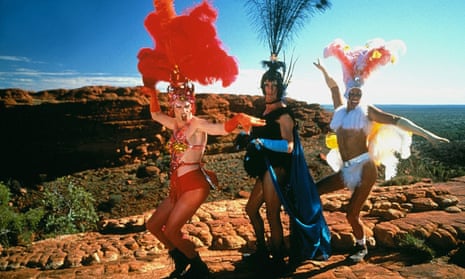
Priscilla, Queen of the Desert sequel in works with original cast, director confirms
Stephan Elliott says Hugo Weaving, Guy Pearce and Terence Stamp are ‘onboard’ and the sequel will be set partly in Australia but will also head overseas
- Get our weekend culture and lifestyle email
A sequel to The Adventures of Priscilla, Queen of the Desert is in the works, director Stephan Elliott has confirmed, with the film’s stars Terence Stamp, Guy Pearce and Hugo Weaving “onboard” to come back.
Elliott confirmed to Guardian Australia that he will serve as director, writer and producer on the sequel and that the script has been finished. The 1994 original starred Weaving, Pearce and Stamp as drag queens who drive a bus – the titular Priscilla – from Sydney to Alice Springs.
All three are “onboard” to return as Tick/Mitzi Del Bra (Weaving), Adam/Felicia Jollygoodfellow (Pearce) and Bernadette Bassenger (Stamp), Elliott confirmed, but said negotiations are continuing with production companies and financiers.
Elliott said he had been reluctant to make a sequel but he began realising that “I had something that needed to be said”.
“People have been screaming for me to do this for 30 years. And suddenly I had the realisation that we’re all getting old. We’re losing people,” Elliott said. “And with Trump coming in now – it’s all about to erupt again. Somebody said to me, ‘Is this the right time to make this film?’ I said, ‘It is the perfect time to make this film.’
“People think of the original film as a lot of costumes and music and great fun, but it’s also a dagger in the heart. I’m not going to do just tits and feathers.”
He said that though Stamp is now 85 years old, “Terence is the fittest man I’ve ever met in my life. He has never drunk and basically eats grass. It took him a long time to think about it until he got there, but eventually he said to me, ‘You know what? You’re right. We’re not finished yet. The story is untold.’”
Sign up for the fun stuff with our rundown of must-reads, pop culture and tips for the weekend, every Saturday morning
The story will be partly set in Australia but Elliott said it will also head overseas.
“You have to remember that Tick had a kid – now that kid has grown up and now he’s got his own family,” he added. “We have our three principals, but we have to build in the new world.”
Elliott said the script has taken him five years to write, but it took the death of his father and mother, in 2020 and 2023 respectively, to make him buckle down and finish it.
after newsletter promotion
“This is not a dire story, it is pretty extravagant. I’m going to give RuPaul a run for her money, let me tell you that,” he added. “But I don’t want to repeat myself, so it’s taken me a long while to come up with something, to realise that there’s something that needs to be said about tolerance.”
The announcement of a sequel, first revealed in Deadline , comes soon after Guardian Australia revealed that the bus used in the original film had been found in remote New South Wales , 30 years after it disappeared.
The History Trust of South Australia is now restoring the vehicle to the state it was in the film, having been damaged years out in the open and by bushfires and floods. Elliott has confirmed “the bus will feature” in his film.
“When the bus surfaced it felt like, is this some kind of celestial lineup?” he added. “There’s lots of work to be done. But we’re off.”
- Australian film
- The Adventures of Priscilla, Queen of the Desert
- Hugo Weaving
- Terence Stamp
Comments (…)
Most viewed.

Casket believed to have belonged to Mary, Queen of Scots to go on tour
A silver casket believed to have been owned by Mary, Queen of Scots and which was acquired by National Museums Scotland in 2022 has undergone fresh conservation work ahead of going on tour to Kirkcudbright and Stirling.
Images of the casket being conserved can be downloaded here . Video can be downloaded here . A 3D model of the casket can be viewed here.
An iconic piece of Scotland’s national heritage, the casket will go on display at Kirkcudbright Galleries from 2 November 2024 - 27 April 2025 then at Stirling Smith Art Gallery & Museum from 30 April – 31 August 2025. Its display at both venues is supported by the Weston Loan Programme with Art Fund.
To prepare the casket for the tour, centuries of tarnish and corrosion have been removed. The technique of electrolytic reduction was used via a pen-like device, allowing the delicate gold and silver surfaces to be cleaned in a highly controlled and targeted manner without the need for any abrasive polishing.
Made in Paris, probably between 1493 and 1510, the casket is a superb and extremely rare work of early French silver, very little of which survives, even in France. It is likely that its long-standing association with Mary has kept it preserved for over 450 years.
For three centuries, it was owned by the family of the Dukes of Hamilton, following its acquisition, around 1674, by Anne, Duchess of Hamilton. According to a handwritten note stored with it from the late 17th century, she bought the casket, previously owned by Mary, Marchioness of Douglas, on the understanding that it had belonged to Mary, Queen of Scots.
The note records the belief that this is the casket which played a dramatic role in Mary’s downfall when, in December 1568, a similar casket was produced at a hearing ordered by Elizabeth I against Mary at Westminster. This contained what have become known as the Casket Letters. These love poems and letters, allegedly from Mary to her third husband, the Earl of Bothwell, implicated them both in a conspiracy to murder her second husband, Lord Darnley.
Dr Anna Groundwater, Acting Keeper of Scottish History and Archaeology at National Museums Scotland said:
“One of Scotland’s national treasures, this extraordinary casket has been venerated as a relic of Mary, Queen of Scots for centuries, and I’m delighted that more people will have the opportunity to see it up close when it goes on tour later this year. Beyond its connections to one of Scotland’s most famous figures, it is a rare and spectacular piece of historic silver in its own right.”
It is thought that the casket was given to Mary by her first husband, François II of France, and came to Scotland with her in 1561 after his death in 1560. Her inventories from this time list multiple examples of precious jewellery and other such valuable objects.
A casket first appears in the records following Mary’s arrest in 1567 by the rebellious Confederate Lords, when it is discovered in the hands of Lord Bothwell’s servant. It was brought before the Scottish Privy Council where its lock was struck off to reveal its contents. Precisely what these were at that moment is unknown. However, a year later, when the Earl of Moray dramatically produced the same casket at Westminster, it now contained the damning Casket Letters.
The authorship of the letters remains a subject of debate, but it is widely thought that they were doctored. Following the hearing at Westminster, Mary remained in English captivity for 19 years, until she was executed in 1587 for her involvement in the Babington Plot to assassinate Elizabeth I, and place Mary on the English throne.
Councillor Jackie McCamon, Vice Chair of Communities Committee and speaking on behalf of Dumfries and Galloway Council said:
“This is such an exciting loan. We a re pleased to be working with the National Museums Scotland once more, a key partner for Kirkcudbright Galleries over the years, and have no doubt this will be an emotional and stirring exhibition. I personally can’t wait to see it”
Caroline Mathers, Director of the Stirling Smith Art Gallery and Museum said:
“The Smith Art Gallery and Museum is delighted to be partnering with the National Museum of Scotland to bring the Mary, Queen of Scots Casket to Stirling. This extraordinary treasure gives us a glimpse into the life of a Queen who has captured imaginations around the world for hundreds of years. A story of power, oppression and ultimately, betrayed. It’s as good a story as it gets.”
The casket was acquired for the nation in 2022 for £1.8 million thanks to support from the National Heritage Memorial Fund, Art Fund, the Scottish Government and several trusts, foundations and individual donors.
Its display in Kirkcudbright and Stirling is supported by the Weston Loan Programme with Art Fund. Created by the Garfield Weston Foundation and Art Fund, the Weston Loan Programme is the first ever UK-wide funding scheme to enable smaller and local authority museums to borrow works of art and artefacts from national collections.
Sophia Weston, Deputy Chair of the Garfield Weston Foundation, said:
“One of the key aims of the Weston Loan Programme is to bring world class objects to regional museums so that they can be enjoyed by as many people as possible. We are delighted to support the display of this very special piece of Scottish history in Kirkcudbright and Stirling where it can be seen in a new context by local audiences.”
The tour of the Mary, Queen of Scots casket is part of National Museums Scotland’s National Strategy, which sees collections and expertise shared through loans, participation in national projects, community engagement, funding for acquisitions and free knowledge and skills development opportunities for museums across Scotland.
Over 2500 objects are currently on loan to Scottish organisations, bringing the National Collection to audiences across the country. These include two rare, decorative panels dating from the 16th and 17th centuries which feature in Perth Museum’s debut exhibition Unicorn and an 800-year-old Bishop’s crook, or crozier - made from gilt bronze and adorned with enamel inlay – which has recently gone on display in Whithorn Priory Museum.
Find out more about Mary, Queen of Scots and some of the objects associated with her in National Museums Scotland’s collection here.
Notes to editors
- National Museums Scotland is one of the leading museum groups in the UK and Europe and it looks after collections of national and international importance. The organisation provides loans, partnerships, research and training in Scotland and internationally. Our individual museums are the National Museum of Scotland, the National Museum of Flight, the National Museum of Rural Life and the National War Museum. The National Museums Collection Centre in Edinburgh houses conservation and research facilities as well as collections not currently on display.
2. Opened in 2018, Kirkcudbright Galleries is the newest Arts and Museums site owned and run by Dumfries and Galloway Council. With a completely re-designed interior the 19th century Kirkcudbright Town Hall, is now an exciting art gallery housing a permanent display of the Kirkcudbright Artists’ Collection, as well as an exciting range of temporary exhibitions throughout the year. www.kirkcudbrightgalleries.org.uk
3. The Stirling Smith Art Gallery and Museum is a place where everyone is welcome. The building has played a very special part in the history of Stirling since its founding in 1874. Established by the bequest of artist Thomas Stuart Smith (1815-1869), it was built on land supplied by the Burgh of Stirling. Today, The Smith functions as a gallery, museum, and cultural centre for the Stirling area. It serves as the repository for the historical artefacts and paintings of Stirlingshire, while also offering exhibition opportunities for contemporary artists. The Smith is a much-treasured resource in our community, valued for its lecture theatre, café, and biodiversity garden as well as exhibitions. www.smithartgalleryandmuseum.co.uk
4. Established in 1958, the Garfield Weston Foundation is a family-founded grant-maker that gives money to support a wide variety of charities across the UK. The Foundation’s funding comes from an endowment of shares in the Weston family business – a successful model that still exists today. The Weston family have a consistent aim. The more successful the family businesses, the more money the Foundation can donate. Each year the Foundation gives away its income and donations have continued to grow. Since it was established it has donated over £1.4 billion, of which over half has been given away in the past ten years. In the most recent financial year the Foundation gave away nearly £90 million to over 1,980 charities across the UK.
5. Art Fund is the national charity for art, helping museums and people to share in great art and culture for 120 years. Art Fund raises millions of pounds every year to help the UK’s museums, galleries and historic houses. The charity funds art, enabling the UK’s museums to buy and share exciting works, connect with their communities, and inspire the next generation. It builds audiences, with its National Art Pass opening doors to great culture. And it amplifies the museum sector through the world’s largest museum prize, Museum of the Year, and creative events that bring the UK’s museums together. Art Fund is people-powered by 135,000 members who buy a National Art Pass, and the donors, trusts and foundations who support the charity. The National Art Pass provides free or discounted entry to over 850 museums, galleries and historic places, 50% off major exhibitions, and Art Quarterly magazine. www.artfund.org
- Home
- / Our doctrine
- / Principles of National Restoration
- / Holy Russia
- / Vladimir Soloviev, prophet of Russia's conversion
VLADIMIR SOLOVIEV prophet of Russia’s conversion
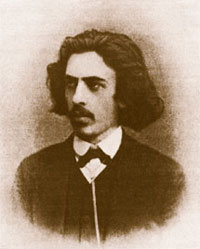
T HE conversion of Russia will not be the work of man, no matter how gifted he may be, but that of the Immaculate Heart of the Virgin Mary, the Mediatrix of all graces, because this is God’s wish, which he revealed to the world in 1917. The life and works of Vladimir Soloviev are a perfect illustration of this truth of Fatima. He whom our Father regards as « the greatest Russian genius of the 19th century », was in his own way a prophet of the “ conversion ” of his beloved Country, announcing the necessity of her returning to the bosom of the Roman Church. « Rome or chaos », such was his catchphrase, Rome whose anagram is not a matter of chance, but a providential sign, a definition: ROMA , AMOR . Led by this incomparable guide, we would like « to anticipate in our thoughts, our hearts and our prayers this consecration, this long-awaited conversion, which must mark the beginning of a time of sacred peace throughout the world, the beginning of the universal reign of the Most Blessed and Immaculate Heart of Mary, and through Her, of God’s Kingdom » (English CRC, December 1982, p. 23).
A PERSONAL CONVERSION
Through the example of his life, Soloviev recalls the indispensable means of this immense work: self-renunciation, personal and collective sacrifice, in Russian the podwig , the only way in which the Church, nations, saints and heroes can become the instruments of God’s designs. If he managed to surpass his master Dostoyevsky by his « truly universal Catholicism and far superior mystical vision », this was not without without a conversion of mind and heart on his part.
Our Father summarises the principal stages of his life as follows: « Born of an honourable Muscovite family, of part Kievian ancestry, Vladimir Soloviev began, in a world where only Germany counted, by being a victim of all the poisons of the West. He himself relates how he was a zealous materialist at the age of thirteen, had read Renan’s Life of Jesus at fifteen, and had become an evolutionist and therefore (!) an atheist and a nihilist at eighteen, in « It was Spinoza and then Schopenhauer who pulled him out of this bottomless void. Whereupon in 1872 a mysterious encounter with “ Wisdom ” suddenly shook him out of the scientific naturalism in which he had been vegetating and made him aware, as he says, of invisible Beauty, the “ Sophia tou théou ”, the daughter of God. He thus became the fervent witness of Wisdom’s indwelling in the world and of Her desire for total incarnation and universal queenship. His quest for wisdom, scientific, aesthetic and mystical, had commenced. He was nineteen years old. The quest would never end for this new style Russian pilgrim ; it would be of an unparalleled fruitfulness despite its touching brevity. He died of exhaustion in 1900, at the age ! » (English CRC, December 1982, p. 35)
We will limit ourselves in this article to his prophetic insights on the Union of the Churches. In his Lessons on Theandry (1878) – he was then twenty-five ! – our philosopher applies himself to contemplating the Wisdom of God at work in history, perfectly incarnated in Jesus and His virginal Mother, as well as in the Church as she awaits her eschatological transfiguration. The most serious sin, throughout this history, has been that of schism. Who is responsible for this vast Vladimir Soloviev began by throwing all responsibility for it on the Catholic Church, so much so that he provided the inspiration for Dostoyevsky’s famous “ myth of the Grand Inquisitor ” in The Brothers Karamazov . But, at the beginning of the 1880’s, through studying the question more closely, he understood that the sin of schism was in fact that of the East. This was a stroke of genius on his part for which our Father commends him greatly:
« I must beg pardon of my master Msgr. Jean Rupp, of Solzhenitsyn, Volkoff and so many others, but it seems obvious to to me, as it did to Soloviev in the end, that the schism of Moscow in setting itself up as the third Rome was the beginning of all the ills suffered by these admirable Christian peoples of European Russia . And I must say so because this rupture still weighs heavily on the world of today and because it is precisely of this rupture that Our Lady of Fatima speaks when She foretells “ the conversion of Russia ”. (English CRC, December 1982, p. 24)
Let us follow Soloviev in his commendable mystical conversion which has opened up a path of light for his people, allowing a spring of grace and mercy to gush forth.
AN EVANGELICAL DISCOURSE
In 1881, Soloviev published a long article, still very antipapist, entitled Spiritual power in Russia . There the pope was presented as Antichrist institutionalised ! Our theorist placed all his hope in the regenerative mission of Holy Russia and in the Tsar who was to be her « divine figure, religious guide and animating wisdom ». But were the Russian people still capable of accomplishing such One particular event was to shake Soloviev’s patriotic faith. On March 1, 1881, Alexander II was assassinated by revolutionaries. A few days later, Soloviev gave a Discourse in which he recommended that his successor, Alexander III, show mercy to the regicides. Certainly not as a matter of weakness or abdication before the Revolution, even less out of the spirit of non-violence that a certain Tolstoy was already preaching, but « as an example of Russian piety », that famous podwig « which lies at the heart of the Russian people’s evangelical soul, of which the tsar is the living icon ». Alas, Soloviev was not understood... This was a painful stage in his life, the first step he had taken beyond his master Dostoyevsky.
The following year, he published another article entitled “ Schism in the Russian people and society ”. Delving deep into the past, he accused Metropolitan Nikon of having broken, at the time of Peter the Great, the communion, the Sobornost , so beloved of the Russian people, by excommunicating Raskol, the fierce guardian of traditional popular religion... Ever since then, the Orthodox hierarchy, enslaved to the imperial power, had proved powerless to govern and sanctify Orthodoxy. It was nothing now but a shrunken, secularized “ local Church ” which, if it were to be restored and revived, would need to open itself up to “ the universal Church ”.
In the spring of 1882, Soloviev was powerfully affected by an unusual dream. In his dream he met a high-ranking Catholic ecclesiastic and entreated him to give him his blessing. The priest refused, so Soloviev insisted, declaring, « The separation of the Churches is the most disastrous thing possible. » Finally, the ecclesiastic agreed to give him his blessing.
This premonitory dream was to awaken in Vladimir Soloviev a burning desire for reconciliation with Catholicism, and to stimulate him to write a series of articles to be published every month in his friend Aksakov’s slavophile newspaper Rouss and then to be collected together in a work with the resonant title: The Great Controversy and Christian Politics . One particular maxim constantly reappeared under the Russian writer’s pen:
« FIRST AND FOREMOST WE MUST WORK TO RESTORE THE UNITY OF THE CHURCH, AND TO MAKE THE FIRE OF LOVE BURN IN THE HEART OF CHRIST’S SPOUSE . »
By an irony of fate, the term “ Controversy ”, which for Soloviev referred to the conflict between Rome and the East, was going to give place to a bitter controversy between himself and his Orthodox and slavophile friends.
A MARVELLOUS AND ADORABLE WISDOM
T HE world’s beauty appeared to Soloviev as a living figure, a real existence, changing and yet immortal. He saw her and held her as the queen of his spiritual universe under her venerable name of Sancta Sophia . At the end of his life, in 1898, he celebrated the Three Encounters he had had with this Beauty which for him was Wisdom.
“ Three times in his life he had been overwhelmed by the radiant visit of Wisdom who appeared to him in the form of an absolutely heavenly female being, dazzling him and enlightening him profoundly. Not without reason certain authors think that all his religious and even philosophical works derive from this illumination. ”
And let us immediately point out, in order to acclimatize the Western reader who is highly likely to be disconcerted by these accounts, that trustworthy interpreters of Soloviev have attributed a marian character to these visions. For them, the whole of the Philosopher’s work derives from the AVE MARIA GRATIA PLENA . “ It is a marvellous perspective ”, adds Msgr. Rupp. “ Wisdom is closely allied to the Immaculate who is its seat. ” ( Le message ecclésial de Soloviev , p. 340)...
What I am going to say next will perhaps surprise my reader. Nothing is more biblical than this vision, and I am astonished at the astonishment of theologians and their impatient criticisms. This Sophia was already well known, hymned and even boldly adored by the scribes of the Old Testament under this very name of Wisdom. Far from being “ pantheist ”, this idea, this vision touches the essence of created beings, and is clearly poles apart from the Platonic idea and far more profound than Aristotle’s substance; it lies at the very heart of being, there where nothing exists except relationship to God, the term of a will and a wisdom that are infinite, there where exists a pure reflection, a fragment of the image of God’s beauty.
George de Nantes , A mysticism for our time , French CRC no. 133, p. 7.
THE GREAT CONTROVERSY

In January 1883, he fired the opening shots with an open letter to Aksakov: « As I reflected on the means of curing this interior disease (of Christianity), I became convinced that the origin of all these evils lies in the general weakening of the earthly organisation of the visible Church, following her division into two disunited parts. » He demonstrated that, in order to establish herself on earth and to endure throughout history, the Christian religion had need of a higher authority, and he explained that it was therefore essential to restore « the union of all Christian and ecclesiastical forces under the standard and under the power of one central ecclesiastical authority ».
On February 19, Soloviev gave a talk in homage to his master Dostoyevsky. It was almost a panegyric of the Roman Church ! He declared his ardent hope for the reconciliation of the two Churches, for the two parts of the universal Church which should never have been separated and whose centre lay in... Rome . As a result of this speech, he saw himself banned from speaking in public. The newspapers made no mention of his speech. For the first time, and it would not be the last, Soloviev was the victim of the censure of Constantin Petrowitch Pobiedonostev, Russia’s Grand Inquisitor and the Tsar’s adviser on religious matters. Pobiedonostev championed a sacral conception of political power, akin to that of the French legitimists of the time, but he was fiercely Orthodox, and any opening towards the Catholic religion was pitilessly censured.
Soloviev responded to this censure with a smile. So his speech had been described as « infantile chattering » ? « If we are not converted », he said to his friends, « and become like little children again, we will not enter the Kingdom of Heaven. » He went on: « When I was a pretentious little boy [teaching German philosophy: Kant, Hegel, Fichte, Schopenhauer and Nietzsche], people listened with great respect to my “ truly infantile ” prattling. And now it is fitting that the only way I can attain the perfection of humility is by everyone ! »
At the same time, he wrote to Aksakov: « It is necessary to defend Catholicism against the false accusations being brought against it... Consequently, in advocating a reconciliation with Catholicism, I assume that Catholicism is not in principle erroneous, for one cannot be reconciled with error . » Now there we have a true ecumenism ! The life of Soloviev, writes our Father, « was ».
To the charge of “ papism ” levelled against him, Soloviev responded in March 1883 with an admirable profession of faith, already Catholic:
« It seems to to me that you concentrate only on “ papism ” whereas I focus first and foremost on the great, holy and eternal Rome, a fundamental and integral part of the universal Church. I believe in this Rome, I bow before it, I love it with all my heart, and with all the strength of my soul I desire its rehabilitation for the unity and integrality of the universal Church. And may I be accursed as a parricide should I ever utter one word of condemnation against the Holy Church of Rome . »
THE REALISATION OF THE DREAM
In May 1883, on the occasion of the coronation of the Emperor Alexander III, the Moscow press complained that too many concessions were being made to restore diplomatic relations with the Vatican broken in 1866, but Soloviev protested: such an agreement was necessary, were it only to improve relations with the Catholics of Poland. The Pope was represented at the ceremony by his special envoy Msgr. Vincenzo Vanutelli. Had not Alexander III written to Leo XIII shortly beforehand: « Never has unity between all Churches and all States been so necessary, in order to realise the wish expressed by Your Holiness of seeing the peoples abandoning the disastrous errors responsible for the social malaise and returning to the holy laws of the Gospel... »
A few days after the ceremony, Soloviev was crossing Moscow in a hired car. Suddenly, he recognized the route he had followed in his dream the previous year. Soon he came to a stop in front of a house from which a Catholic prelate was just leaving: it was Msgr. Vanutelli in person... There was the same hesitation of this latter to give his blessing to a schismatic, and the same entreaties of Soloviev, who finally !
In the summer of 1883, our author wrote two articles on The Catholic Question . According to Soloviev, it was for Russia to take the first step towards the Catholic Church. Imagine !
His articles were not of the sort to leave his readers indifferent. On the Orthodox side, there was an increasing irritation, while on the Catholic side, surprise soon gave way to enthusiasm. The news crossed the borders, spreading to Poland and even to Croatia, where Msgr. Strossmayer was finally seeing his desires realised. The jurisdiction of his diocese of Djakovo extended into Bosnia and Serbia, that is into Orthodox territory. Endowed with a superior intelligence and animated by great apostolic zeal, this Croatian bishop keenly felt the need for a true, intelligent and benevolent ecumenism. He wrote in 1883 to one of his friends, Father Martynov:
« In my opinion, the principal task of the Catholic Church and of the Holy See this century is to draw as closely as possible to the Slav nation, principally the Russian nation . By winning it over to the divine unity of the Catholic Church, we would at the same time win over everyone in the world who still possess a positive faith. »
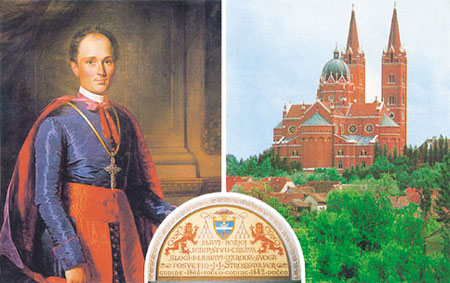
IN THE RADIANCE OF THE IMMACULATE
In the summer of 1883, Soloviev wrote five long letters to a Russian Uniate priest on the subject of The Immaculate Conception of the Most Blessed Virgin Mary . At the same time he translated Petrarch’s “ Praise and prayer to the Most Blessed Virgin ”, wherein he contemplated Her “ clothed in the Sun, crowned with stars... Her glance radiating infinity ! ” It is highly significant that Soloviev was simultaneously attracted by the mystery of the Catholic Church and the mystery of the Immaculate Virgin. The dogma of the Immaculate Conception was the first Catholic dogma which he embraced, and his favourite painting was the Immaculate Conception by Murillo.
In The Foundations of the Spiritual Life (1884), he exalted the « All Holy and Immaculate » Virgin Mary. In Russia and the Church Universal (1889), he would praise Pope Pius IX for having quoted, in support of his dogmatic definition, the Old Testament texts referring to Wisdom, the “ Sophia ” of his personal intuitions:
« If, by the substantial Wisdom of God, we were exclusively meant to understand the Person of Jesus Christ, how could we apply to the Blessed Virgin all those texts in the Wisdom books which speak of this Wisdom ? However, this application, which has existed from the very earliest times in the offices of both the Latin and Greek Churches, has today received doctrinal confirmation in the bull of Pius IX on the Immaculate Conception of the Most Blessed Virgin. » (quoted by Msgr. Rupp, Le message ecclésial de Soloviev, p. 338)
In September 1883, when the sixth chapter of The Great Controversy was published, a rumour spread through Moscow that Soloviev had “ passed over ” to Catholicism, but there was no truth in it. Moreover, curious though this may seem to us, he was not looking “ to pass over to Catholicism ”, but only to open Orthodoxy up to the universality of the Roman Church.
His seventh and final chapter aroused a lively debate, one that is ever topical. The question turned on the attitude of the Byzantine Greeks in conflict with the Crusaders of the West. Soloviev wrote: « On the day that Constantinople fell, seeing the Turkish armies poised to attack, the final spontaneously expressed cry of the Greeks was, “ Better Islamic slavery than any agreement with the Latins. ” I do not mention this as a reproach to the unfortunate Greeks. If, in this cry of implacable hatred, there was nothing Christian, then neither has there been anything especially Christian in all the formal and artificial attempts to reunite the Churches… »
Aksakov, his Orthodox pride deeply irritated by this remark, retorted: « What does he mean, nothing Christian ? May the Greeks be blessed a hundred times over for having preferred a foreign yoke and bodily torture to the abandonment of the purity of their faith in Christ and for having thus preserved us from the distortions of papism at the precise moment [ the beginning of the 13th century ! ] when it had reached the height of its deformity. May they win eternal glory for this ! »
Nonetheless, Soloviev continued his search for truth, surmounting every obstacle. His article “ Nine Questions to Father Ivantsov-Platonov ” published in December 1883, created a deep stir even in the West. Here he put nine questions to his former master in Orthodoxy on those points of controversy which set the Church of the East against the Church of Rome. Here is the setting:
« How is it that the countries of the East are separated from the Roman Church ? Did the latter proclaim an heretical proposition ? One would be hard pushed to maintain this, for the addition of the Filioque to the Creed, which is put forward to justify the separation, does not have the character of a heresy. Furthermore, it is absurd to say that the Roman Church is in a state of schism with regard to the Eastern Churches. Thus, the latter’s separation from the former has no basis. Let us acknowledge this and, putting aside all human viewpoints, let us work towards Unity or rather let us work so that Unity, which already has a virtual existence, may become a reality. »
THE THREAD OF AN ANCIENT TRADITION
During 1884, the Russian philosopher studied Catholic dogmatics. He read the works of Perrone, the theologian of Gregory XVI and Pius IX, as well as the texts of the Councils. He was particularly interested in Popes Gregory VII and Innocent III, whom he read in the original text.
At the same time he had a great enthusiasm for the Croatian priest George Krijanich who « had come from Zagreb to Moscow in the 17th century to spread the ideal of the Holy Kingdom of God, Roman Catholic and panslavic, gathering together under the sceptre of the tsars and the crook of the Pope all the Slav peoples who would thereby be freed and protected from the twofold burden pressing them on both sides like a vice, the Germanic powers and the Turks. Thus the Croats would work to free themselves from Austrian control and at the same time they would assist the Serbs, their Orthodox brothers, to shake off Moslem domination.
« To realise this grand design, capable at one blow of powerfully advancing the Kingdom of God on earth, Krijanich came to Moscow and preached on the subject of Russia’s reconciliation with Rome . This should not be difficult, he said, because the Russians had only fallen into schism through ignorance and not through heresy or malice. He himself was already preaching that everyone should recognise their own individual faults, be they unconscious or involuntary, and the need for expiation. God’s blessings would follow as a result, immense and eternal blessings. Sergius Mikhailovich Soloviev, our great man’s father, a historian and the author of a monumental history of Russia, admired Krijanich as “ the first of the Slavophiles ” and also, in his eyes, “ the most paradoxical ”, so alien did Catholicism then appear to the Russian consciousness. » (English CRC, December 1982, p. 32)
Soloviev intended to prove the contrary. And it was just at this time that he entered into friendly relations with the Croatian Bishop Strossmayer, thereby resuming the thread of an ancient tradition, one which was apparently marginal but which in reality was pregnant with a splendid future. Early in December 1885, Soloviev for the first time received a letter from the Croatian bishop. He replied to him on December 8, “ the blessed Day of the Immaculate Conception of the Most Blessed Virgin ”:
« On the reunion of the Churches », he wrote, « depends the fate of Russia, the Slavs and the whole world. We Russian Orthodox, and indeed the whole of the East, are incapable of achieving anything before we have expiated the ecclesiastical sin of schism and rendered papal authority its due . » And he ended with these words: « My heart burns with joy at the thought that I have a guide like you. May God long preserve your precious leadership for the good of the Church and the Slav people. » In his pastoral letter of January 1886, the bishop of Djakovo quoted large extracts from this letter.
Encouraged by such support, in 1886 Soloviev undertook a study on Dogmatic development and the question of the reunion of the Churches , which provoked the fury of Orthodoxy. However, at a conference given at the ecclesiastical Academy of Saint Petersburg, Soloviev attempted to justify himself: « I can assure you that I will never pass over to Latinism. » He thereby sought to register his attachment to the Eastern rite. No question for him of adopting the Latin rite ! After that, he set out on a journey to Europe.
FIRST STAY IN ZAGREB (1886)
At the beginning of July, he was the guest of the honourable Canon Racki, President of the Yugoslav Academy of Zagreb, founded by Msgr. Strossmayer, and a personal friend of the latter. Every morning the Orthodox Soloviev assisted at the Catholic Mass with great enthusiasm. He made the sign of the cross in the Catholic manner, but prayed in the Greek manner, crossing his arms on his chest. He willingly admitted to his host – and this was not due to any desire to please on his part – that Croatian Catholics, like the Ukrainians, were more religious than his Orthodox compatriots !
Following an article published in the Croatian journal Katolicki List , Soloviev for the first time encountered opposition from a Catholic priest.
During his stay in Zagreb, he also published a letter in the Russian newspaper Novoie Vremia , wherein he refuted the widespread opinion in Russia that the Croats were the instruments of the Austro-Hungarian government’s attempt to Latinize the Eastern Slavs.
In August, he joined Msgr. Strossmayer in the Styrian Alps, and spent ten marvellous days with him. These two minds were truly made to get along. The mutual admiration they felt for one another reinforced their spiritual friendship. But Soloviev continued to receive Holy Communion at the hands of the Orthodox priest of the Serb parish of Zagreb... Rising above the inevitable criticisms, he then wrote a letter to Msgr. Strossmayer, summarising their initial conversations:
« The reunion of the Churches would be advantageous to both sides . Rome would gain a devout people enthusiastic for the religious idea, she would gain a faithful and powerful defender. Russia for her part, she who through the will of God holds in her hands the destinies of the East, would not only rid herself of the involuntary sin of schism but, what is more, she would thereby become free to fulfil her great universal mission of uniting around herself all the Slav nations and of founding a new and truly Christian civilisation, a civilisation uniting the characteristics of the one truth and of religious liberty in the supreme principle of charity, encompassing everything in its unity and distributing to everyone the plenitude of the one unique good. »
Such was his transcription of the well known Catholic principle: « In necessariis unitas, in dubiis libertas, in omnibus caritas : unity in essentials, liberty in matters of doubt, and in all things charity . Such must be the Charter of Catholic ecumenism under the crook of the one Shepherd. From the start of this crisis, such has been the invitation we have made to our bishops and to our brothers. Today, it is also the will of the Holy Father », wrote our Father in his editorial for September 1978, dedicated to John Paul I, another Saint Pius X without knowing it (English CRC no. 102, p. 6).
When he informed his friends of Soloviev’s letter, Msgr. Strossmayer presented its author as « a candid and truly holy soul ».
Msgr. Strossmayer and Soloviev had agreed to meet again in Rome for the jubilee pilgrimage of 1888. The Croatian bishop decided to pave the way in Rome by writing to Leo XIII’s Secretary of State, Cardinal Rampolla. He presented his Russian friend as « toto corde et animo catholicus ». The Pope at first took a personal interest in the affair: « Here is a sheep », he said, « who will soon be clearing the gate of the sheepfold. » But curiously, there was to be no follow-up. It seems that Leo XIII failed to appreciate Soloviev’s genius... However, things were different in France, where an unassuming and ardent rural parish priest latched on to everything that his apostolic zeal could extract from the lightning advances made by the Russian thinker ( see inset , p. 19).
Soloviev returned to Russia at the beginning of October 1886, rather discouraged by the criticisms directed against him on all sides: there were the Orthodox, some of whom had accused him of bringing Orthodoxy into disrepute abroad... and certain Catholics, like Fr. Guettée in France, a modernist priest with little to commend him, whom he had met in Paris in 1876 and who had recently published an article of rare violence against him !
THE “ RETURN OF THE DISSIDENTS ”
June 18, 1887: a young Capuchin, Leopold Mandic, from Herzeg Novi in Bosnia, under the jurisdiction of Msgr. Strossmayer, and studying at the friary in Padua, heard the voice of God inviting him to pray for and promote the return of the Orthodox to the bosom of the one Church of Christ. « The goal of my life , he would later say, must be the return of the Eastern dissidents to Catholic unity; I must therefore employ all my energies, as far as my littleness allows, to co-operate in such a task through the sacrifice of my life . » Fifty years later, he would still remember this grace: « June 18, for the record: 1887-1937. Today, I offered the Holy Sacrifice for the Eastern dissidents, for their return to Catholic unity . » Thus the Heart of Jesus and the Immaculate united, in this one same “ ecumenical ” work, the ardent heart of a young Capuchin destined for the altars, the apostolic wisdom of a bishop and the brilliant intuitions of a great thinker.
In January 1887, from the Monastery of Saint Sergius where he had celebrated Christmas, Soloviev wrote an article in which he provided philosophic justification for the three Catholic dogmas which the Orthodox reject, namely the Filioque, the Immaculate Conception and papal infallibility . Here is a « basis for working towards the reunion of the Churches », he explained. A few months later, he published in Zagreb (on account of the censure directed against him in Russia) his book The History and Future of Theocracy .
There he retraced the vast movement of history towards the establishment of the Kingdom of God. Universal Theocracy, the successor of Jewish Theocracy, cannot be conceived, he explained, without an integrally Christian politics, and he concluded with a splendid anthem to Christ Pantocrator receiving from His Father all power on earth and in Heaven and acting through His emissaries, the Apostles and their successors. Soloviev always believed in the privileged vocation of Russia within the Catholic community of Christian nations, even if he stigmatized what he called “ the sin of Russia ”, which was to oppress and hate all those it dominated, in particular Polish Catholics, Greek Uniates, Ruthenians and Jews !
Like a true prophet, he was vigorous in preaching repentance to his people . In order that they might be faithful to their vocation within the great Slav family, Soloviev asked them to give up their inordinate ambitions, to return to a truer and more Christian conception of their destiny, and to accomplish this within the only international organization which could direct its course, Catholicism, that is to say Roman universalism.
« One of my theses is that the cause of the Reunion of the Churches in Russia demands a podwig (sacrifice) even heavier to bear than that which, already demanding great self-denial, was needed to ensure Russia’s receptivity to Western culture, an event truly disagreeable to the national sentiment of our ancestors .
« Well ! this sacrifice consists in drawing closer to Rome and it must be attained at all costs. In this lies the remedy for the Russian sin . »
It goes without saying that Soloviev earned himself new enemies with his book. It cost him great personal suffering, but he could not fail the Truth, which he contemplated with ever greater clarity... What greatness of soul this universal genius possessed !
SAINT VLADIMIR AND THE CHRISTIAN STATE
1888 marked the ninth centenary of the baptism of Saint Vladimir, the first prince of Kiev, whose kingdom after his conversion became « the model of Christian States, with evangelical morals », writes our Father (English CRC, December 1982, p. 23). Soloviev used the occasion to give a conference in Moscow, where he reaffirmed that Russia’s destiny was to turn towards Rome, as King Vladimir had ! However, having hardened itself in its schism, the Muscovite hierarchy was no longer animated by the spirit of St. Vladimir. Hence the fury of the Orthodox hierarchs !
At the same time, Msgr. Strossmayer had gone to Rome for the Jubilee. In vain did he wait for Soloviev there. The latter, fearing perhaps that he had made a definitive break with the Orthodox world which he dreamed on the contrary of winning for the Union, had given up the idea of making this journey. It must also be said that Vatican diplomacy hardly inspired more confidence in him. Leo XIII was revealing himself less and less slavophile, reserving his favours for the Germany of old Bismarck and the young William II ! Msgr. Strossmayer lamented this in a letter to Fr. Martynov: « The Pope is acting against the Slavs. The Roman prelates are like people insane and think only of temporal power ! »
What a difference between Leo XIII and his successor, St. Pius X, who was, in the words of Msgr. Rupp and our Father, the greatest slavophile pope of our times !
Early in May 1888, Soloviev was on a visit to Paris. To explain his thinking to the French public, he gave a conference on the Russian Idea , « the true national idea eternally fixed in the design of God », who longs to spread His light over the whole world. However, Soloviev remained lucid about his own Church: « If the unity of the universal Church founded by Christ only exists among us in a latent state, it is because the official institution represented by our ecclesiastical government and our theological school is not a living part of the universal Church. »
In passing, he described the destruction of the Greek-Uniate Church by the Orthodox as a « veritable national sin weighing on Russia and paralysing her moral strength ». That is still the case today...
In July, Kiev celebrated the feast of the baptism of St. Vladimir. From Zagreb Msgr. Strossmayer sent a telegram in which he exalted Russia’s future role in the manner of his friend Soloviev. Scandal ! His remarks were universally reported by the press. Cardinal Rampolla informed the Croatian bishop that Leo XIII was seriously displeased ! The bishop of Djakovo also earned himself the bitter reproaches of Emperor Francis Joseph of Austria, which is more understandable given the rivalry existing between the two Empires.
In the summer of 1887, Soloviev published in the Universe , the newspaper of Louis Veuillot, three articles on St. Vladimir and the Christian State which caused a great stir. Then he journeyed to Croatia where he remained for one whole month with Msgr. Strossmayer. This meeting was rather sad, for the two friends were increasingly aware that their attempt to reunite the Churches would not succeed, at least in their lifetime.
It was in Djakovo that Soloviev finished the immense prologue to his magisterial book, Russia and the Church Universal , in which one can already glimpse signs of the discouragement that would overwhelm the thinker in the latter part of his life. We know from Fatima that the work of the conversion of Russia, something humanly impossible, has been entrusted to the Immaculate Heart of Mary who has a particular love for this Nation such as to inspire jealousy in others. But this only makes it all the more extraordinary that our prophet should have traced out the course of this conversion, like a true Precursor !
« RUSSIA AND THE CHURCH UNIVERSAL »
Soloviev does not hesitate to delve deep, extremely deep, into the past. To realise its designs in the world, divine Wisdom wished to become incarnate, and the Verb to take flesh like our own. As that was not enough, He also wished to unite to Himself a social and historical body, one that could reach the universality of mankind and communicate to all men His own divine Life. In this magnificent perspective, Soloviev compares the formation of that Body through which God wishes to be united with humanity to that effected in the womb of the Virgin Mary at the time of the Incarnation, and to that which operates every day in the Eucharistic mystery... What was needed for this work was a solid foundation, a Rock:
« This bedrock has been found », he writes, « it is Rome. It is only on the Rock [of Peter and his successors] that the Church is founded. This is not an opinion, it is an imposing historical reality . »
It is also an evangelical truth: « You are Peter, and on this Rock I will build my Church . » Here Soloviev addresses the Protestants who seek to outbid each other in their attacks against the Primacy of Peter by quoting Jesus’ own words to His Apostle when he was obstructing the Master’s path: « Get behind me, Satan ! » Soloviev’s response once again shows the clarity of his intelligence and his perfect knowledge of Catholic dogma:
« There is only one way of harmonising these texts which the inspired Evangelist did not juxtapose without reason. Simon Peter, as supreme pastor and doctor of the universal Church , assisted by God and speaking for all, is, in this capacity, the unshakeable foundation of the House of God and the holder of the keys of the heavenly Kingdom. The same Simon Peter, as a private person, speaking and acting through his own natural forces and an understanding that is purely human , can say and do things that are unworthy, scandalous and even satanic. But personal defects and sins are passing, whereas the social function of the ecclesiastical monarch is permanent. “ Satan ” and the scandal have disappeared, but Peter has remained. »
Soloviev’s doctrine agrees with that of Vatican Council I and with that of our Father who, at the same time as he makes us venerate Peter’s magisterium, magnificently illustrated by Blessed Pius IX, St. Pius X and John Paul I, accuses John XXIII, Paul VI and John Paul II of being instruments of “ Satan ” for the ruin of the Church.
However, Christ wished that it should be around Peter that the unity of faith and charity should be formed: « Since the unity of the faith does not presently exist in the totality of believers, seeing that not all of them are unanimous in matters of religion, it must lie in the legal authority of a single head, an authority assured by divine assistance and the trust of all the faithful . This is the ROCK on which Christ founded His Church and against which the gates of hell will never prevail. »
Why did this ROCK settle in Rome, and not in Jerusalem, Constantinople or Moscow ? Here we have a further brilliant response from Soloviev: historically Rome represented the order, civilization and terrestrial Empire that would best allow the Church to become the universal spiritual Empire desired by Christ. In a mystical view of the history of Salvation – we would say divine “ orthodromy ” – Soloviev shows how God, wishing to extend salvation to the whole world, decided one day that His Kingdom should leave Israel for Rome, so that the capital of the pagan Empire should become “ the conjoint instrument ” of His designs:
« The universal monarchy was to stay put; the centre of unity was not to move. But central power itself, its character, its source and its sanction were to be renewed... Instead of an Empire of Might, there was to be a Church of Love. » One thinks of Constantine’s conversion and his imposition throughout the Roman Empire of laws favouring Christianity, and of Theodosius declaring the Christian religion the religion of State. What decisive support for the Gospel ! The remarkable Roman civilization, already the heir of Greece, was put at the service of the Cross of Christ !
Soloviev had some wonderful expressions to describe this, as for example the following: « Jesus unthroned Caesar... By unthroning the false and impious absolutism of the pagan Caesars, Jesus confirmed and immortalised the universal monarchy of Rome and gave it its true theocratic foundation . »
« Let us not think », comments our Father, « that our theosophist loses his way in a contemplation of evangelical love and freedom. Fully aware of the frailty and shortcomings of humanity, he declares that it is essential, for its effective salvation, that supreme divine power be joined to the firmest social structure, to the virile principle , and not as formerly to the female principle of a virginal flesh for the Incarnation. This firm principle is the imperial monarchical institution which is Rome and Caesar. Converted, elevated and unabolished, the Power of Rome continues in the Pope for the service of the universal community.
« It is only this divino-human pontifical paternity that is capable of forming the basis of the universal fraternity of the peoples, not only through its spiritual influence but also through its authority and its supranational organization. In this monarchy, sacred but popular, the Pope, the Universal Emperor, clearly remains the servant of the servants of God and is, for that very reason, the sovereign Head of the Nations. Opposed to any kind of papolatry, antagonistic to all the encroachments of papism, and quite capable of denouncing such a Pope as Satan, Soloviev raised an imperishable monument to the glory of Rome and pointed out – him, a member of the Orthodox Church – the path of the world’s salvation, which lay in one place only, in the universal Christian order of a restored Roman Catholic Church ... » (French CRC no. 131, July 1978, p. 6)
In his lifetime, Soloviev ran up against a wall of hostility and incomprehension: « I am not so naive », he said, « to seek to convince minds whose private interests are greater than their desire for religious truth. In presenting the general evidence for the permanent primacy of Peter as the basis of the universal Church, I have simply wanted to assist those who are opposed to this truth, not because of their interests and passions, but merely because of their unwitting errors and hereditary prejudices. »
The final period of his life might seem to some like a decline and a renunciation of his prophetic insights, but our Father writes: « Soloviev was too great a mind to be discouraged or to modify his ideas in accordance with the fluctuations of his worldly success. What is certainly true is that his bitter experiences gave him a better knowledge of the Evil that was at work in the world, throwing up formidable obstacles to God’s designs and going so far as to erect a kind of caricature of them. This he denounced as the power of the Antichrist, the Prince of this world, announced in the Scriptures. » (French CRC no. 132, August 1978, p. 12)
At the beginning of the 1890’s, relations between Soloviev and the Orthodox Church deteriorated. « Given the papaphobia reigning among us , he wrote to a friend, sometimes revealing its underhand character and at other times its stupidity, and always in any event unchristian, I considered and I continue to consider that it is necessary to draw people’s attention to the Rock of the Church laid by Christ Himself and to its positive significance . »
As he persisted in his criticisms, even going so far as to compare the Greco-Russian Church with « the Synagogue », the Orthodox hierarchy, in the person of Pobiedonostev, the Holy Synod’s prosecutor, employed the ultimate weapon at its disposal: it deprived him of the sacraments. One day in 1894, being seriously ill, Soloviev asked to receive the sacraments. His Orthodox confessor refused to give him absolution unless he renounced his Catholic views. Soloviev refused to yield, preferring to forego confession and Holy Communion.
AN AUTHENTIC CONVERSION
The moment had come. On February 18, 1896, he went to see Fr. Nicholas Alexeyevich Tolstoy, a Catholic priest of the Eastern rite exercising his ministry in Moscow. This priest, a former officer, owed him his vocation, his formation (Soloviev having been his teacher) and his conversion to Catholicism. That February 18 was the feast day of Pope St. Leo so dear to Soloviev. Before Mass, he read on his knees the Tridentine symbol of the faith containing the Filioque and a formula declaring that the Church of Rome must be regarded as the head of all the particular Churches. Then he received the Body of Christ at the hands of the Catholic priest.
On the following day, Fr. Tolstoy was denounced and arrested. He managed to escape and to reach Rome first, then France. It was only in 1910 that he would give an account in the Universe of the authentic conversion of Soloviev, and in 1917 that the two witnesses present at the scene would confirm the celebrated Russian’s profession of the Catholic faith. Nevertheless, this conversion was disputed not only by the Orthodox but also by Catholics imbued with a false ecumenism like Msgr. d’Herbigny of sinister memory. But in this matter the facts are indubitable. His entry into the Catholic Church did not, however, in Soloviev’s mind, exclude him from what he called « the true and authentic Eastern or Greco-Russian Church ». Never did he embrace the Latin rite. After the exile of Fr. Tolstoy, as there were no longer any Catholic priests in Moscow apart from those belonging to the Latin rite, Soloviev decided to refrain from receiving the sacraments...
In 1897, a census of the whole of Russia was carried out in which a question was asked about religion. « I am both Catholic and Orthodox; let the police work that out ! » Soloviev answered.
« Self-important people from Rome and Moscow declared themselves scandalized », writes our Father. « The hour had not yet come for the podwig , for self-renunciation and reconciliation in truth and justice ( pravda ), and for the restoration of the wholly divine unity of communion in love ( sobornost ). Msgr. Rupp thinks that we achieved it with Vatican II. Alas, no ! I hope for and expect it to come with Vatican III... but only after the trial, after conversion and expiation... and after Our Lady’s humble requests have been met. » (English CRC, December 1982, p. 36)
UNDER THE SIGN OF MARY
« This glow from Heaven emanates from Mary, And vain remains the attraction of the serpent’s venom. »
On July 17, 1900, sensing death approaching, Soloviev sent for a priest. He was most insistent about this: « Will it be morning soon ? When will the priest come ? » The next day, he made his confession and received Holy Communion at the hands of an Orthodox priest. He died peacefully a few days later, on July 31, « in the communion of Russian Orthodoxy to which he had ever been faithful, without however disowning the Catholicism of his heart, assured by the example of the Fathers of Russian Christianity, Saints Cyril and Methodius, Saint Vladimir, and so many strastoterptsi , innocents who had suffered the passion , and startsi , slavophiles and romanophiles at the same time, without schism or constraint, in the love of Holy Church and Holy Russia, the Kingdom of God to come ! »
But all this is too beautiful for us not to revisit it, so our Father has decided that we will study in more depth the work of this great Russian thinker, in three parts to appear in subsequent editions of Resurrection , Deo volente:
The vocation of Russia in the designs of God and the concert of the Christian nations: up to and including Putin ?
The Immaculate Virgin Mary , throne of Wisdom, essential beauty of the created world, our ultimate recourse !
The Antichrist unmasked by Soloviev . This was the last service the “ inspired prophet ” rendered to his beloved Russia: that of putting her on her guard against the seductions of the Antichrist. In Rome, at the same time, St. Pius X was also announcing his advent in his encyclical E supremi Apostolatus of October 4, 1903: « The Antichrist is present among us. The Evil shaking the world should not affright us, it will only last a short while. What must fall will fall, and the Church will be reborn from the trial, assisted by her Saviour and ready for extraordinary developments. »
Brother Thomas of Our Lady of Perpetual Help He is risen ! n° 8, August 2001, pp. 13-22
Reference */?>
- Holy Russia
- Vladimir Soloviev, prophet of Russia's conversion
- The Immaculate Conception and the Divine Sophia
- Soloviev (Vladimir)
- Our founder
- The 150 Points of the Phalange
- Catholic Counter-Reformation Analyses
- Preparing the Catholic Renaissance
- Principles of National Restoration
- New publications on the CRC website
- Archives HE IS RISEN!
- Books of Accusation
- Make a donation
- CCR Glossary
- VOD website
- Nederlandstalige site
- Articoli in italiano
- Artículos en español
- Artigos em Português

IMAGES
VIDEO
COMMENTS
The Works Tour was the tenth headlining concert tour by the British rock band Queen to promote their successful 1984 album The Works.During the tour, Queen participated in the Rock in Rio festival in 1985; the concert was released on VHS. The band released a DVD from a concert in Tokyo titled We Are the Champions: Final Live in Japan, but the name of the concert was incorrect as the band ...
The Works Tour was a concert tour by Queen. Following the release of the band's 1984 album The Works, Queen went on the tour to promote the album throughout Europe and Asia. This was the first concert tour by the band to not to feature a US tour leg, as the commercial failure of Hot Space led to dwindling sales in the United States. The tour was notable for the grand stage designs, large ...
25.04.1985 Sydney, Australia. 15.05.1985 Osaka, Japan. The tour begins with two performances at the Rock In Rio festival. Both are filmed and an official video is released. Unfortunately, Queen weren't on top form and neither were the Brazilian cameras so the Rock In Rio video isn't worth watching. The last night of the tour (Osaka) was much ...
Supporting the album 'The Works'.
Share your videos with friends, family, and the world
The Works Tour, 1984-1985. Part One (to be continued...). A collection of very rare live performance mixed by Fabio Tosti. Videos & Music by my collection (b...
The Works is the eleventh studio album by the British rock band Queen.It was released on 27 February 1984 by EMI Records just shortly after recording for the album had been completed in the United Kingdom and it is the band's first studio album to be released by Capitol Records in the United States. After the synth-heavy Hot Space (1982), the album saw the re-emergence of Brian May and Roger ...
The Works Tour Instruments: The Works Tour [24.08.1984 - 13.07.1985] 660 days without playing a single concert, and then back with a new tour with several changes, the most important being Spike Edney on synths, piano and guitar.
It was April 13, 1985, during the final leg of Queen's The Works tour, and Mercury was, in his own words, "fucking pissed". Pop dandies Spandau Ballet were having a day off on their New ...
A worldwide tour followed, which included several concerts with audiences topping 100,000 in Latin American in 1981. That same year, Queen worked with David Bowie on the single "Under Pressure", a spontaneous occurrence, as Bowie happened to drop by the studio while Queen were recording, and another huge success, reaching number one in the UK.
I think the Works is their worst tour. Roger's drum sound was rubbish and they over-relied on medleys to cover their earlier songs. The stage was alright, but I think the Magic tour stage was better. Not saying the tour sucked or anything, I'd give my left nut go to be able to experience a Works show today. 31.
The Works. By Parke Puterbaugh. April 12, 1984. "Radio Gaga," the single that opens up the new Queen album, is another instant jewel in Queen's Top Forty crown. It's one more anthemic ...
Following the disappointing reception to Hot Space and the lengthy and often grueling world tour, the band decided to take a break from each other and either work on their own or take some time to relax with their families. For three-quarters of the band, 1983 started off peacefully enough, until their own creative juices started to flow again, and solo work became the priority for the year ...
The concert took place in the final run of Queen shows during the worldwide tour in support of the album The Works. Each picture disc is held in a polythene inner bag and has its own die cut sleeve, which is in shrink-wrap. These are stored in a slipcase type outer box, which itself is shrink-wrapped also. It has a die cut thumb section.
Gary Mullen & The Works Official USA Tour NOW ON SALE! Check out all our 2023 tour dates.
The Freddie Mercury Tribute Concert - 32 Years On... Read more . News. 19th April 2024 Out Today: New Ian Hunter Album Featuring Brian. Read more . News. ... Big Spenders On Campus, Queen Make Their US Live Debut. Read more . News. 15th April 2024 'Queen Rock Montreal' Coming to Disney+. Read more . News. 14th April 2024 The QuEx Tour: Thank ...
A Monday finish will take place at the RBC Heritage after the final round was suspended due to darkness Sunday evening at 7:45 p.m. ET. Play resumes at 8 a.m. o
Madonna may be the reigning Queen of Pop, but she's a mother first.. As the "Vogue" singer approaches her 80th show on her "Celebration" tour, she took a moment to appreciate how much ...
#Queen #Queen 1984 #Queen the works tour #Queen the works tour 1984
Thu, 25 April 2024, 11:34 am GMT-4 · 4-min read. A silver casket believed to have been owned by Mary, Queen of Scots and which was acquired by National Museums Scotland in 2022 has undergone fresh conservation work ahead of going on tour to Stirling. An iconic piece of Scotland's national heritage, the casket will go on display at ...
30 years after the release of "The Adventures of Priscilla, Queen of the Desert," the cult classic from director Stephan Elliott is getting a sequel. Original trio of stars Terence Stamp, Guy ...
Helgeland's involvement in a "Game of Thrones" spinoff was revealed as early as 2017, a few years before the flagship HBO series came to an end. In May 2021, screenwriter Amanda Segel was ...
A sequel of Australian cult classic The Adventures of Priscilla, Queen of the Desert, is in the works with the original main cast all on board, the film's director says, 30 years after the ...
Moscow Metro. The Moscow Metro Tour is included in most guided tours' itineraries. Opened in 1935, under Stalin's regime, the metro was not only meant to solve transport problems, but also was hailed as "a people's palace". Every station you will see during your Moscow metro tour looks like a palace room. There are bright paintings ...
The musician shares exclusive photos from the 'Celebration' tour, and what it's like to work with son David and daughters Mercy, Stella, and Estere. ... It's also the Queen of Pop's most ...
Moscow Metro private tours. 2-hour tour $87: 10 Must-See Moscow Metro stations with hotel pick-up and drop-off. 3-hour tour $137: 20 Must-See Moscow Metro stations with Russian lunch in beautifully-decorated Metro Diner + hotel pick-up and drop off. Metro pass is included in the price of both tours.
A sequel to The Adventures of Priscilla, Queen of the Desert is in the works, director Stephan Elliott has confirmed, with the film's stars Terence Stamp, Guy Pearce and Hugo Weaving "onboard ...
El setlist definitivo de la gira de The Works. Fue usado en Sun City en 1984, Rock in Rio (Brasil), Australia y Japón en 1985. Después Queen se "reconsagrarí...
A silver casket believed to have been owned by Mary, Queen of Scots and which was acquired by National Museums Scotland in 2022 has undergone fresh conservation work ahead of going on tour to Kirkcudbright and Stirling. Images of the casket being conserved can be downloaded here. Video can be downloaded here.
Vladimir Soloviev, aged twenty. T HE conversion of Russia will not be the work of man, no matter how gifted he may be, but that of the Immaculate Heart of the Virgin Mary, the Mediatrix of all graces, because this is God's wish, which he revealed to the world in 1917. The life and works of Vladimir Soloviev are a perfect illustration of this ...